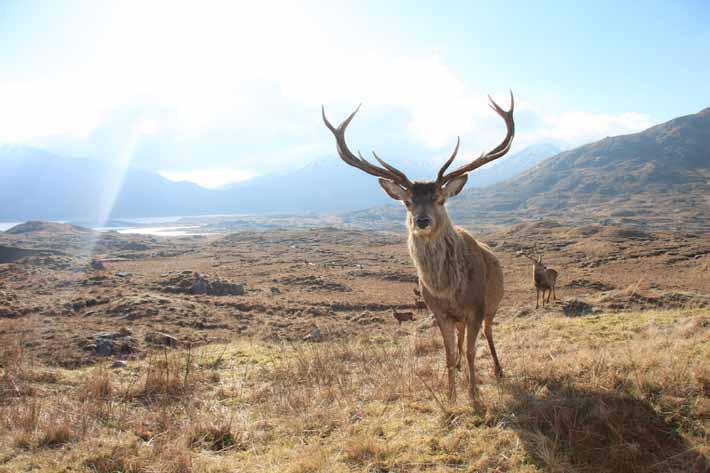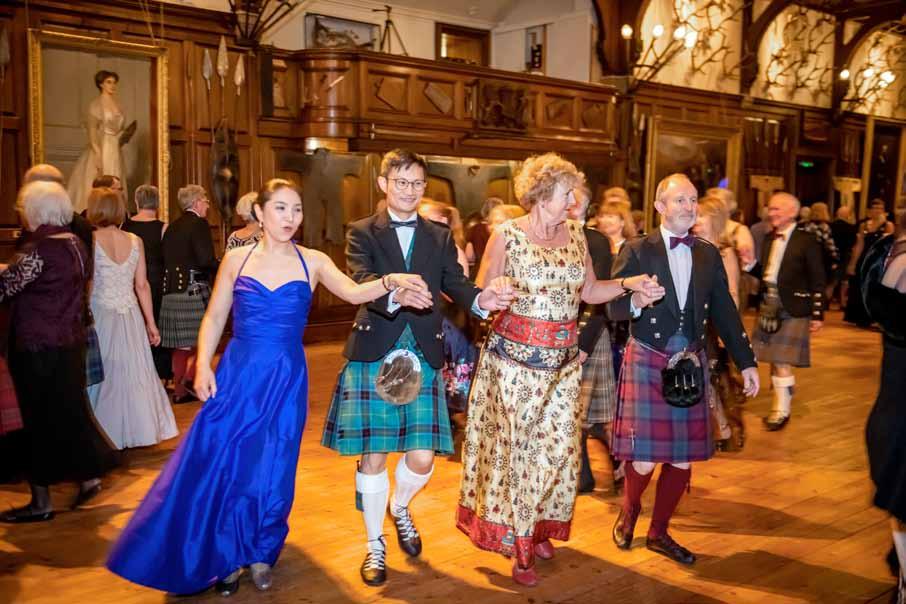No 39 October 2024


No 39 October 2024

95th AGM & AUTUMN GATHERING 2024
1 – 3 NOVEMBER 2024
MEADOWBANK SPORTS CENTRE, EDINBURGH
Join us for a weekend of dancing and discussion. The Autumn Gathering provides an opportunity for dancers from across the world to gather over a weekend full of activities in Autumn.
Teachers: Graham Donald (Saturday class), Faye McNeil (Sunday class)
Musicians: Muriel Johnstone (Saturday class), Adam Brady (Sunday class)
Bands: Gordon Shand (Friday dance), Jim Lindsay (Saturday ball)
SOUTHERN FLING 2024 MELBOURNE
22-24 NOVEMBER 2024
MELBOURNE, AUSTRALIA
Southern Fling is a weekend of Scottish country dance for young people and is open to dancers aged up to 40. All those attending can look forward to a fantastic weekend of dancing, socialising and making friends. Come and join us in Melbourne!
WINTER SCHOOL 2025
16 - 21 FEBRUARY 2025
PITLOCHRY, SCOTLAND
Enjoy daily dance classes, whisky tasting, social dances each evening and a ball on your last night at the spectacular Blair Castle.
Director: Ian Robertson
Musicians: Ian Robertson, Jim Lindsay, Ewan Galloway and Muriel Johnstone
Teachers: Graham Donald, Alice Stainer, Deb Lees and Andrew Nolan
Bookings open in September 2024.

Taking dancers on a journey from Scotland around the world and back. Come together on 23rd November 2024 at home, in a small group or at a Branch level!
SPRING FLING 2025 BRIGHTON
11 - 13 APRIL 2025
BRIGHTON & HOVE, ENGLAND
Spring Fling is a weekend of dance, organised by young people, for young people, supported by the Youth Services Committee. Spring Fling is open to dancers aged 35 and under and all those attending can look forward to a fantastic weekend of dancing, socialising and making friends.

UNIVERSITY HALL, ST ANDREWS
Summer School is an action-packed RSCDS event full of dancing and music in the historic town of St Andrews. Join fellow dancers and musicians from around the world for a week or two of classes and social dancing. Summer School is open to both members and non-members.
Director: Fiona Mackie
Bookings open in November 2024.

Our joy in Scottish country dancing is seen in the fun of weekto-week classes, in dancing at local events, in the excitement of a ball with a band invited to highlight a significant celebration, and perhaps most of all, in the pleasures of life-long friendships. We are fortunate to engage in an activity that has made important contributions to Scottish culture. That is enhanced by the knowledge that this joy has been shared by cultures far removed from Scotland.
Our organisation plays an active role in preserving and promoting Scottish culture. We treasure, celebrate, and share our history through the contributions of our members who have sustained local classes, devised dances, composed music, and travelled worldwide to teach Scottish country dancing and its history.
The Society’s early members had limited access to libraries, publications, or manuscripts, though they had some personal recollections of how dances were done, particularly Ysobel Stewart’s notes. With the expansive resources available to us now, we can see that the reconstruction of some of the dances in the early books is questionable, and many of them are no longer danced. How different would our tradition be if the early members had known that in the 18th and 19th centuries, ‘down the middle and up’ was always a progressive figure, with the first couple finishing in second place? The poussette that followed was more of a ‘waltz’ poussette right round.
While the history and reconstruction of older dances may seem of interest only to those with an esoteric, academic bent, it is worth considering that these dances might be more enjoyable if they were reconstructed differently.
In this issue, we have an article by Peter Knapman, a member of the Research Group, exploring this very question: how ‘traditional’ are our traditional dances? From the New Zealand Branch, Rod Downey shares his success teaching early RSCDS book dances to local dancers, a practical application of the results of examining the early books.
We have articles with a historical perspective, some highlighting interesting and unusual activities of current members. An interview with Aberdonian dancer Alastair Reid provides newer dancers with a fascinating look at the Society and its activities in the 1950s and 1960s. In addition to those whose primary Society affiliation is with the International Branch, many dancers worldwide enjoy an associate membership. Fiona Grant shares the 20-year history of this “most unusual branch”.
Many thanks to those who submitted letters to the editor; we appreciate your thoughts and concerns. However, the bi-annual publication schedule makes any meaningful dialogue challenging. I hope to discuss this with the Editorial Team and members of the Management Board to see what alternatives might be available.
We have a wealth of historical knowledge and contemporary experiences to inspire our creative minds. Enjoy our present, celebrate and explore our past, and forge into the future.
Marjorie McLaughlin,Editor,San Diego,California
Cover: Dancers taking part are Antje Boettcher, Rory Dyer, Gisela Koehne, Jennifer Norris, Samantha Schad, Colin Boettcher, Mia Corliss, Beth Fairbairn, Zoe Hill, Torben Jonathan Kutche, Freya Marshall, Anthonia McClintock, Olivia McClintock, Alice Pernthaller, William Thomson and Hannah Breingan. Photographer: Grant Keenan from Mr Drew Photography, Dundee.
Want to receive the Scottish Country Dancer in an interactive digital magazine? Go to your “Edit my Profile” and update your preferences.
Alternatively, contact your branch membership secretary.
The next issue of Scottish Country Dancer will be published in April 2025. Please refer to Notes for Contributors on the website. Send materials for inclusion to the editor: mag.editor@rscds.org no later than 31 January 2025. Please send enquiries about advertising to Cécile Hascoët: mag.advertising@rscds.org


The RSCDS achieved a lot during 2023-24:
l Awarded £14,252 in grants
l Provided 24 scholarships for Summer School, Winter School and Spring Flings, enabling young dancers and musicians to attend.
l Provided support for Scottish dance teachers and musicians
l Partnered with The National Gallery of Scotland and Education Scotland
l Launched the Health Strategy Implementation Working Group to encourage social prescribing
l Launched Dance Around the World CD
Discover more about the work we do in our Annual Review 202324: https://rscds.org/about/governance/legal-administrative
Membership
Total Membership: As of the end of March 2024, the RSCDS membership stands at 9,650, marking a slight increase from last year’s total of 9,622 members.
Branch Performance:
l 71 branches reported an increase in membership.
l 20 branches maintained the same membership levels as the previous year.
l Notable growth has been observed in overseas branches, particularly in North America and Europe.
Gifts in Memory, Celebration & Tribute Funds
This year, the RSCDS has received generous donations from the families and friends of Kenneth Whittle (UK), Joyce Deddens (KY, USA), Kathy Corson (KY, USA), Ken Blackwood (Canada), and Iain McLellan (UK). The office holds an In Memoriam book, a personalised place to remember someone special. You can share your loved one’s memories, thoughts, and stories and collect donations in their memory.


The Kiltwalk: Over £5,000 was raised for the RSCDS, thanks to 185 supporters and pictured (from the left) ‘Gary Coull ChairElect, William Williamson Chair, Linda Williamson YS Convenor Elect, Lizzie Berridge, Sebastian Wanless Glasgow Branch member, Jon Berridge Chief Operating Officer of RSCDS, and Scotch the dog.’
(The Kiltwalk is Scotland’s largest mass participation walking event that raises funds for many Scottish charities).
BRANCH AWARDS
Congratulations to all the Branch Award recipients.
Kathleen Anderson Aberdeen Branch
Pete Anderson Orange County Branch
Margaret Baker Royal Leamington Spa Branch
Katherine Barber Kirkcudbright Branch
Sheila Barnes York & North Humberside Branch
Jodie Beckley Detroit Branch
Muriel Bone Glasgow Branch
John Bottrell Ottawa Branch
Kate Bould Sheffield Branch
Joy Bradshaw Richmond Branch
Sandra Carroll Canberra and District Branch
Linda Mae Dennis Portland Branch and Southwest Washington State Branch
Isobel Hunter Windsor, Ontario Branch
Elaine Hutchison Croydon and District Branch
Catherine Livsey Leeds Branch
Fiona McDonald Glasgow Branch
Sachiko Masumoto Tokai Branch
Noriko Nishimori Tokyo Branch
Dorothy Pearson Croydon and District Branch
Margaret Sanders Glasgow Branch
Nicola Scott Birmingham Branch
Frank Thomson
Aberdeen Branch
David M Watson Edinburgh Branch
Congratulations to our New Teachers 2024
Summer School, St Andrews
Giorgia de Luca (Italy)
Heather Cook (UK)
Kristian Vestli (Norway)
Marie-Laure Barret (France)
Philippa McKee (UK)
Saskia Frisby (UK)
Teresa de Heredia (Portugal)
Amy Luxton-Esler (New Zealand)
Clare Nash (UK)
Lucy Abel (UK)
Niall Bootland (UK)
Sarah Ferguson (Canada)
Shona Holmes (UK)
Tristan Gerrie (Canada)
Violaine Eysseric (France)
TAC (Teachers’ Association of Canada), Summer School
Cathie Frise (Canada)
Deena Mills (Canada)
Mary Gray (USA)
Ted Randolph (USA)
CTI,
Since 2021, we have had 19 members who have completed their CTI.
John Aitken UK
Armaiti Bedford UK
Tracy Mackenzie Australia
Su Marshall New Zealand
Christine Scott Canada
E B Van Otterloo USA
Thomas Ward USA
Ian Marshall New Zealand
Anne Johnson USA
John Sheard New Zealand
Stephanie Speake Portugal
John Campbell UK
Janine Holden Australia
Erica de Gannes Canada
Maggie Sutherland Canada
Barbara Gray Portugal
Dianna Bailie UK
Douglas Hedley UK
Peter Holmes UK

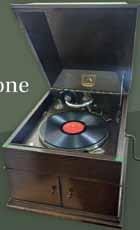
The Archive is busier than ever, with many new accruals. Recently, there has been a large influx of recorded music, both LPs and 78 rpm records. As a result, the Archive Recorded Music Catalogue is now quite extensive and covers recordings made in the 1920s through to the 1970s/80s when the production of vinyl records started to decline. There is an ongoing Archive project to catalogue and digitise these recordings and make them available for the personal use of members. With the present Archive resources, this could take a very long time!! The Archive catalogue lists holdings of old 78 rpm records of SCD Music by many of the well-known band leaders and musicians from the past, such as Jimmy Shand, Adam Rennie, Jim Cameron, Michael Diack, William Hannah, Annie Scott Shand, George Davie and Tim Wright to name but a few.
Music in Recorded and Printed Form - RSCDS Archive
Perhaps the most significant and interesting recent accrual is a “wind-up” HMV Gramophone, which was donated by a member who was “clearing out”. The Gramophone was manufactured by the HMV Company and dates from the mid-1920s but as yet the precise model remains elusive! It is in excellent condition and is in fully working order, and the quality of the sound is really quite remarkable, helped no doubt by the aid of its built-in sound box.

Listen on our SoundCloud radio ‘Sound from the RSCSD Archive’ Jimmy Shand solo accordion playing music for the Virginia Reel. ca 1935 and J Michael Diack’s Orchestra playing for Strip the Willow ca. 1923, digitised from the original 78 rpm records. Archive, by appointment only: archive@rscds.org)
Interested in the programme, visit the page: https://rscds.org/learn/teacher-training/core-traininginstructors-cti
Board and Committee Membership for 2024-25
Management Board
Election necessary to appoint 3 Trustees for three years 1x ChairElect for two years+ two years as Chair
Chair-Elect Candidate: Sebastian Wanless from the Glasgow Branch
Board Candidate: Christopher Smith, RSCDS Perth and Perthshire; Carlos Candia, RSCDS International Branch
Membership Services Committee:
Election necessary (6 candidates for 5 posts of differing lengths) No election is necessary to appoint Members: 2 (for 3 years), 2 (for 2 years), 2 (for 1 year)
Candidates:
Beatric Wepner Vienna Branch
Deborah Crossley Sheffield Branch
Katharine Hoskyn New Zealand Branch
Niall Bootland Glasgow Branch
Paul McKnight Aberdeen Branch
Susan MacFadyen Headquarters.
Education and Training Committee:
Election necessary for 1 x Convener-Elect (for 1 year + 3 years as Convenor), 3 x (for 3 years) , 1 x (for 2 years)
Convenor Elect: Graham Donald - Headquarters
Candidates:
Abbie Brown Youth Branch
Aymeric Fromherz Paris Branch
David Queen Ribble Valley Branch
Deirdre MacCuish Bark Toronto Branch
Fiona Grant Bristol Branch
Ian Stewart Herts and Borders Branch.
Youth Services Committee:
No election necessary 2x (for 3 years)
Emma Sellke Central Germany Branch
William Thomson London Branch

William Williamson
It is a great pleasure to warmly welcome you to this edition of the Scottish Country Dancer, whether you are a dancer, musician, or someone interested in Scotland’s rich cultural heritage. I am sure you will find it entertaining and informative, and I want to thank Marjorie, our Editor, and her team for producing a first-class publication for members.
Enthusiasm, enjoyment, new ideas, and building new friendships are just a few of the very positive aspects I have witnessed over the past six months. Wherever I have travelled, I have met amazing people who are determined to see Scottish country dancing thrive in their communities and to share the fun and inclusiveness that is truly what we represent. I want to thank every single member, in whatever role they have, for helping to ensure our Society is welcoming and friendly; that starts in our local branches and groups! What is the ‘product’ that someone meets when they come through the door for the first time?
The Society’s Board and Committees focus firmly on supporting branches and individual members. Everything done and produced at 12 Coates Crescent must benefit members.
New initiatives include the Health Strategy Working Group. Gary Coull chairs this group, comprised of health professionals from within the Society who are already reaching out to other organisations to promote the health benefits of Scottish country dancing.

Earlier this year, the committee completed a task long on the MS agenda – the Members’ Pack. Various delays were due to debate about the pack’s purpose - to attract new dancers, inform new RSCDS members, update existing members, or to be all things to existing and new members. The decision was taken to concentrate on informing new members about RSCDS membership - benefits, core information, brief history, key RSCDS events, and links to online content. Elements can be utilised for promotional purposes, and hopefully the pack will meet branch demand as the new dancing year starts. However, it is your tool, so please get in touch if you feel there are missing aspects; this digital resource can be updated easily with an ongoing aim to keep the information relevant. Branches can request the Members’ Pack from staff at Coates Crescent: info@rscds.org
Next, ‘Dance Around the World’ - taking dancers from Scotland around the world and back: creating a global dance event on Saturday, November 23rd. We’ve been hearing from branches and groups who will have dances on that day, but the aim is for anyone, anywhere, to dance in their kitchen, garden, or local hall in small or large groups and share photos and videos as widely as possible—even one dance! It was great to be back in the studio in May with Colin Dewar and his Scottish Dance Band for the Dance Around theWorld CD. These new recordings of dances, old and newer, are a great addition to the RSCDS canon. In October, the committee will release a supporting DATW digital booklet sharing information, instructions, and printed music – a digital resource that is free to all.
Everything done and produced at 12 Coates Crescent must benefit members Many thanks to Coates Crescent staff and committee members for their expertise, resilience and hard work.
A communications review is also ongoing. Although there are now more means of communication with members than ever before, a review of how best to use these opportunities is underway. The Society’s events are also being evaluated. These are a few examples of the good work being done by the Management Board and staff at Coates Crescent, and among members. This is sometimes not obvious; however, they are designed to support branches and members in the long term.
We have made great strides since the COVID-19 pandemic; however, if we are to build our dancing community in the future, all our members must be engaged with their local branch and the wider RSCDS organisation.
I hope you will reach out to your communities (I know how difficult that can be) and say to them, “Come and join us, get onto the floor and have fun.” I can assure you that the Management Board, committees, and staff stand ready to support you.
OK! Ready and . . .
As you know, William Williamson was hospitalised recently and underwent heart surgery. He and Linda would like to thank the many dance friends from around the world who took the time to send their best wishes for a speedy and complete recovery. He has been home recuperating, and feeling hale and hearty, as you might expect!
A repeated question heard is: ‘Why do we need new recordings?’ The RSCDS recorded a numbered book CD that covers that dance; is that not enough? Watching this season’s BBC Proms from the Royal Albert Hall made me reflect: would we suggest only one recording in the world of Mahler’s 5th Symphony? Is there one perfect performance of Vivaldi’s Four Seasons? Every performance is different - performers bring nuances, tempi, dynamics, and feelings – all driven by the occasion. Scottish dance is about the connection with the music, and one recording cannot please everyone - different bands inspire different feelings and new recordings include recently composed tunes, important for keeping the tradition alive in the 21st century.
This, my last report, completes seven years as member, convenor-elect, and then MS convenor. Over that period, I have been involved in so many projects aimed at broadening our resources and delivering accessibility, including Dance Scottish at Home, the online classes, Index to Formations and Movements as well as Thirty Popular, Sir Walter Scott - The Heart of Midlothian, Platinum Jubilee, Medal Test Resources, and Book 53 with extended content. Despite the best will in the world, completing every long-standing agenda item hasn’t been possible, but I’ve been grateful to all those I’ve worked with for the tireless effort that has gone into creating RSCDS assets that will, hopefully, stand the test of time.
Many thanks to the 12 Coates Crescent staff and to all MS committee members, past and present, for their expertise, resilience and hard work.

Deb Lees
A summer full of dancing has just drawn to a close, with dancers from all over the world joining us at St Andrews for Summer School. With over 530 dancers and 70 teachers and musicians across the four weeks this year, the RSCDS Summer School is a major event and planning for the following year begins as soon as the last week has finished, if not before. We are enormously grateful to our two Schools Directors, Sue Porter and Fiona Mackie, and their teams. We also thank the staff at the RSCDS office, notably Moira Thomson, for the huge amount of work they all put in to make Summer School a success.
Unit examinations took place at both St Andrews and TAC Summer Schools, with other centres holding exams locally at various points in the year. Congratulations to all who passed their exams and now move on to the next stage of their teaching journey. The job of training our new teachers is a very special and rewarding one, and this year we ran our new tutor training course in both St Andrews and TAC to increase the pool of available tutors around the world. All the prospective tutors attended two online sessions before completing their training, which included three afternoons of practical tutoring experience.
Several new examiners have now completed their training, but we will be looking to increase the number worldwide
Over the past few years, several of our examiners have retired. I want to thank them for their years of service to the Society and their role in ensuring that we have qualified teachers for classes and events around the world. Several new examiners have now completed their training, but we will be looking to increase the number worldwide to have enough available to minimise travel for both cost and environmental reasons.
Continuing Teacher Development remains high on the E&T agenda. Completing the Teaching Certificate or the Core Training for Instructors programme is only the beginning of development as a SCD teacher. Look out for the regular Teachers Newsletter, which has articles and information that interest anyone taking a class. The Virtual Teacher Conference will be back at the end of February, with another week of video presentations on a wide variety of topics. We are revising the Warm-up booklet as some of the advice and guidance in the original booklet has been updated to account for recent research on warm-up and cool-down exercises for dancers. We hope to complete this work over the next few months.
The E&T committee is always busy with various projects and regular ongoing work to maintain all the training and assessment programmes. As we end another year, I would like to thank the retiring members, Ellie Briscoe, Lorna Valentine, and Eilidh Garden, for their immensely valuable contributions to the committee during their terms of office. I am looking forward to welcoming new committee members in November with their ideas and perspectives.
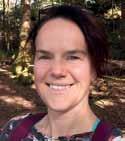
Philippa McKee
Since I last wrote, we have enjoyed a successful Spring Fling held in Cambridge, and I’d like to express my thanks to the organisers for the work they put into making this such a great event. This November, Southern Fling will be held in Melbourne, Australia, and I wish it every success. We are glad to have supported both events with scholarships. We understand the importance of making these events accessible and providing opportunities for young people to enjoy these special occasions. We continue to develop a guidance document incorporating the experiences of organisers to inform and support future Spring Flings. In April, we were able to promote our youth survey and are working through the responses to understand what our young dancers and musicians feel is important so that we can provide better support.
I am delighted to hear about the wonderful experiences of our young dancers at Junior Summer Camp. I am grateful for the contributions of all who made it possible by teaching, providing music and supporting the delivery of this very special course. We hope this course will continue growing and provide the right environment for young people to learn and experience music and dance. At Summer School this year, I was reminded again of the joy of social dance and traditional music. It was an incredible year, and I hope to share this joy back home as our classes resume.
I am delighted to
hear about the wonderful experiences of our young dancers at Junior Summer Camp
We continue to work towards offering a family weekend event. Thanks to all who contributed to the survey earlier this year, the responses to which are being used to inform how this is delivered. The aim is to provide families with an opportunity to participate in their first event in Scotland in 2025; please keep your eyes peeled for news on this.
The uptake in junior membership has been very encouraging; this membership category is open to under 12s, and more information is available on the website. Parents of young dancers can find out more about junior membership here: https://rscds. org/get-involved/young-dancers/join-young-dancers
We are very grateful for the support we have had from Coates Crescent staff. We are so lucky to have their creative input, the support they provide, and the time they put into these projects. Please look out for details of Youth Services work in the magazine, branch mailings, Dance Scottish Together, and on social media. Thanks to the Youth Services Committee for their efforts, ideas and commitment. I have great confidence in the work they will continue to do under the leadership of Linda Williamson. I wish you all the very best.
Reflecting on the last year in my term as Youth Services Convenor, I am heartened and encouraged to hear many positive examples from around the world about our young dancers and musicians. My gratitude goes out to branches who are working to support them. Please share your stories with us; if you can share ideas about what has worked, it would be wonderful to help others do the same. Please get in touch by emailing ysc@rscds.org
In 1997, the RSCDS published the dance Lady Susan Montgomery, a 40-bar strathspey, in its 75th Anniversary booklet. Geoffrey Selling of the Delaware Valley Branch describes the dance “with its gorgeous tune and simple but beautiful choreography” as a personal favorite. This interesting article is the result of his curiosity about who Lady Susan Montgomery might be.
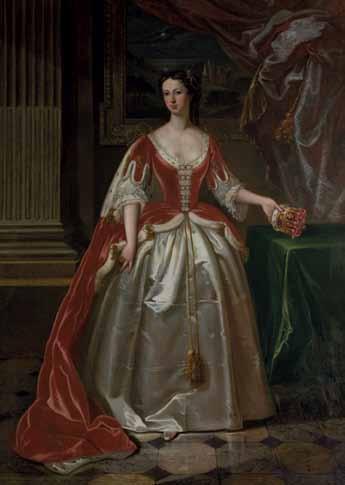
The original dance appears in a 1734 manuscript by David Young and is titled Lady Susan Montgomery’s Hornpipe. The tune is a 32-bar 3/2 hornpipe. The 75th Anniversary booklet incorrectly cites the source as David Young’s 1740 manuscript. That work was the source of many dances in Jack McConachie’s Scottish Country Dances of the 18th Century, but not this dance. The change of tempo and number of bars is odd as 40 bar tunes and dances do not appear in older collections. The Publications and Research Committee took some liberties in rewriting this dance for publication by the RSCDS.
That said, the 20th-century Lady Susan Montgomery as a strathspey is full of turns, gracious handing, and opportunities for covering. Unlike many modern dances where setting, casting, figures of eight, and turning usually lead up to something clever and new, in Lady Susan Montgomery they form the heart of the dance, making it an exquisitely social experience. I have included it on programs and taught it many times, both in my branch and at workshops. It has always been well-received. When I taught it to a class of fully certificated teachers at the RSCDS St. Andrews Summer School, not one teacher among the two sets remembered doing it before, nor had many of them even heard of it.
More recently, as I prepared to teach Lady Susan Montgomery for the 2023 Edmonton Weekend, I began to wonder just who Lady Susan Montgomery was. Scottish dance historian Jimmie
Hill suggested she might have been Lady Susanna Montgomery, the Countess of Eglinton. There is a connection: the dance, Lady Susan Montgomery, most probably honored Lady Susanna’s third daughter, Lady Susan. But the search for that Lady Susan acquainted me with her noteworthy mother, Lady Susanna, renowned as intelligent, well-educated, talented, and famously beautiful. Lady Susanna’s name is linked to two other familiar Scottish country dances: The Gentle Shepherd and Up in theAir.
Family Matters: Lady Susanna was born in 1689 into the Kennedy clan, the daughter of Archibald ‘the Wicked’ and Elizabeth Leslie. Like other women of the Scottish aristocracy, she was educated in the ‘feminine arts,’ how to conduct herself, dress appropriately, and carry herself with elegant deportment. She would also have learned how to manage a household and play the part of a gracious hostess. Both were roles in which she excelled.
As might be expected, Lady Susanna had many suitors, most of whom she disappointed. Among these was the noteworthy Sir George Clark of Penicuik, for whom the gorgeous strathspey to which we dance UpintheAir(Book20) is named. Susanna played the flute, which, in the 18th century, was considered a man’s instrument. To woo her, Sir George wrote the following intimate poem to Lady Susanna and sent it to her rolled up inside a flute: “Since I to her my liberty resign, Take thou the care to tune her heart to mine.”
However, Susanna’s father insisted she wait for a different choice, who would turn out to be 30 years her senior. In 1709, Susanna became the third wife of Alexander Montgomerie, 9th Earl of Eglinton. The earl’s earlier marriages had produced no male heirs, so Eglinton was desperate for a son. Initially, Susanna only produced daughters. The earl was considering a divorce, but his young wife refused - unless he could return her dowry, youth, beauty, and virginity (This sounds remarkably contemporary to me!). Fortunately, a son was born, so the separation never resulted.
Susanna produced 11 children in 15 years: three sons and eight daughters. Her first son, Lord James Montgomerie, died at the age of six in 1724, but all the remaining children reached adulthood, a remarkable accomplishment in a period with high infant mortality. Lady Susanna outlived them all. In 1729, her husband Alexander died, leaving her a widow at 40. She lived another 51 years. She did not remarry but dedicated her life to carefully and thoughtfully rearing her children and managing the family estates. She oversaw the family coal mines and is remembered as having quelled a labor dispute with some miners. She also established a brewery, which did not do as well. None of these roles (mine manager, labor dispute negotiator, and brewery owner) were typical for any class of woman in those days. It was also noted that she had some eccentricities. She was remembered for keeping pet rats, trained to come and even perform a ‘dance’ on command.
Intelligence and Learning: In an era when upper-class women were mainly valued for their beauty, charm, and ability to produce male heirs, Lady Susanna also stood out because of the qualities of her mind. She was well-read and spoke French, German, and Italian. She was comfortable conversing on a range
of subjects that went beyond the conventional feminine topics of music, art, and literature to include science and philosophy, to such an extent that the poet and author Allan Ramsay publicly praised her “superior wit and sound judgment... accompanied with the diviner charms of goodness and equality of mind.” (Ramsay’s Gentle Shepherd, a pastoral comedy, was dedicated to the countess, and we Scottish country dancers know of this play due to the slow jig, The Gentle Shepherd in Book 17. Her interest in literature was seen by her contemporaries as distinctly odd for someone of her station. Sir William Fraser, the Scottish historian, said that “to her loveliness were added the more valuable attractions of genius and great accomplishment.” Samuel Johnson declared, “Her figure is majestic, her manner high-bred, her reading extensive, and her conversation elegant. She has been the admiration of the gay circles of life.”
A Remarkable Beauty: Lady Susanna was known throughout the realm as a truly stunning and elegant beauty. She and her daughters were renowned for walking with the famed ‘Eglinton air.’ All eight of her daughters were known to be beautiful, but none were as famous as their mother. The second daughter, Lady Helen, was said to have remarked, “Who can surpass Mama? She has not aged a day in forty years.” Even Lady Susanna knew it. She once said to her daughter, Lady Bettie, “What would you give to be as pretty as I am?” Lady Bettie replied, “Not half as much as you would give to be as young as I am.” In 1730, when the countess visited King George II’s court (despite her Jacobite sympathies), he was heard to remark that she is “the most beautiful woman in my dominions.” Many writers celebrated Lady Susanna’s magnificent looks, such as Hamilton of Bangor in The LovelyEglintoune. Her portrait, the only painting of a woman displayed in Culzean Castle, her clan’s family seat, was painted by the renowned Gavin Hamilton. It shows a truly grand and elegant woman; she was six feet tall. Robert Chambers described

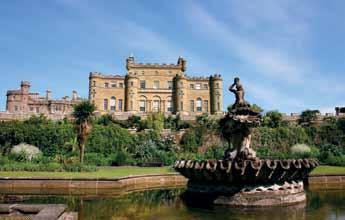
her as having a delicate pale face “of bewitching loveliness.” Lady Susanna did not use make-up but washed her face daily in sow’s milk to help keep her youthful complexion. An admiring Robert Campbell described her face as “like rhododendron and rose flowers dipped in milk.” Nor did age diminish her looks, other than a slight fading of the intense blue of her eyes. Even in her eighties, she was described as a “handsome stout lady,” and remarkably, she lived to the age of 91.
My search for Lady Susan Montgomery thus ended, not with Lady Susan herself, but with her compelling and remarkable mother, Lady Susanna. The Countess of Eglinton was elegant, beautiful, charming, witty, and principled She was also a dedicated mother, a role in which many women of the gentry were less interested. Her ability to conduct herself capably in women’s and men’s affairs makes her a thoroughly contemporary personage. Even by today’s feminist standards, Lady Susanna would have held her own.
Geoffrey Selling, Delaware Vally Branch
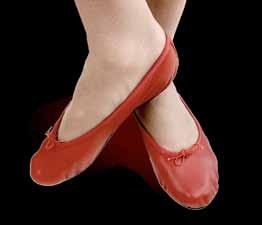
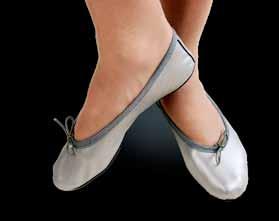
The reel deal since 1954
For 60 years James Senior has been leading the way with our extensive range of Scottish Country and Highland dance footwear. Classic styling married with high-tech full-forefoot in-built shock absorption* ensures you can look the part without getting jiggered.
* James Senior was the first to develop a completely integrated shock absorption system, medically proven to protect the metatarsal area and minimise the risk of injuries associated with Scottish dancing.
Tel: 01334 880545 Email: sales@jamessenior.co.uk

Alastair Reid, now in his 80s, was one of the finest dancers of his generation. One of the first Life Members of the RSCDS, Alastair served on Membership Services. He also served on the Aberdeen Branch committee several times and is a past Chairman of the Branch. In this interview with Jimmie Hill, he describes dancing with the Clan Hay Dancers, who featured in The Kilt is My Delight, the first television programme to showcase Scottish country dancing. He was also on the RSCDS International Team that visited Sweden.

What was your first contact with Scottish country dancing?
It wasn’t at school. I was 14 years old and in a youth club. Margaret Wiseman was one of the leaders. She was only 21, but I thought she was so old! She persuaded me to come to her country dance class. To be honest, I didn’t need a lot of persuading! Margaret became a great friend until the day she died. She was a beautiful dancer who gave a lot to the Society but never took her teaching certificate. The year I started, she entered a set of us for the Aberdeen Festival. The adjudicator absolutely slated us. He told us we were so bad we should never even have entered! We were only 14! As a result, I was the only one on that team to continue. The rest never danced again.
Surely, part of the adjudicator’s job is to encourage children – not drive them away.
The rest just gave it up. They thought that if they were as bad as he had said, there was no point in continuing. Margaret pushed me into demonstrations, and I continued to dance at festivals. I was in the Aberdeen team that competed for the very first Cussons Cup at the Edinburgh Festival, but of course, the Edinburgh team won because Miss Milligan was the adjudicator, and she couldn’t give it to anyone else! It was a foregone conclusion. But the most important thing is encouraging young people, not criticising them. It was Margaret who introduced me to the Clan Hay Dancers.
Was that a demonstration team?

Yes, it was a group started by Captain Jock Hay of Delgatie Castle, near Turriff in Aberdeenshire. It is worth visiting because Mary, Queen of Scots spent three nights there after the Battle of Corrachie in 1562. You can see her bedchamber! Captain Hay restored the castle, which is now the Clan Hay Centre. Anyway, he was a great lover of Scottish tradition and advertised for country dancers to join a team. The great Bobby Watson was in charge of
the dancing. Margaret Wiseman was in the team and suggested to Bobby that I join. It was because of Bobby that we were invited to dance in the BBC programme, The Kilt is My Delight.
What year was that?
It was 1956 – just four years after the start of television broadcasting in Scotland. Many people will have heard of The White Heather Club – the weekly BBC programme from 1958 until 1968. The Kilt is My Delight started two years earlier, so it was the very first television programme to feature Scottish country dancing. It wasn’t on every week. It ran from 1956 until 1963. It did a huge amount to promote Scottish country dancing. Some years there were only 4 or 5 programmes, but in 1960 there were 10. It was more formal than The White Heather Club. A typical programme would have both country and Highland dancing, Scots or Gaelic songs, perhaps a Scots poem, and always a band. The bands were the great bands of the day: Jimmy Shand, Jim Mcleod, Tim Wright, and Ian Powrie. The singers included the most famous Scottish singers: Kenneth McKellar, Moira Anderson, Robin Hall, Jimmie MacGregor, and Mod medallist Kenna Campbell. The Clan Hay dancers with Bobby Watson were regulars, but some programmes had a team from Glasgow or Edinburgh Branch, and a couple of programmes used the Dumfries Branch demonstration team with Jackie Johnstone. The programmes were all live and, of course, to start with, in black and white. Some of the programmes came from the BBC studios in Glasgow, but others came from places like the ballroom at Hopetoun House, the City Hall in Glasgow, the Kelvin Hall, the Pitlochry Festival Theatre, and one programme was televised from Fyvie Castle. It was very time-consuming! We would turn up at the studio in the morning, taking up the whole day before the programme was broadcast live. Because we were amateurs, we weren’t paid, but we got our expenses and were put up in a hotel.
Do you remember what dances you did on the programmes?
You must remember that there had been nothing like this before. We were the first dancers to perform Scottish country dances on the stage. Bobby’s wife, Mavis Watson, was a professional dancer on the London stage. I will never forget her saying, “There’s nothing more boring than people getting on to the floor and dancing a dance eight times in a demonstration! After seeing someone going down the middle and up, you’ve seen enough.” She was a big influence on the Clan Hay dancers. She made sure our performances were interesting. We were the first team to combine different dances in the same performance.
The White Heather Club didn’t do that, did they?
No, they just danced as if it was a social dance. Mavis was the person who invented the kind of demonstration which is common today. If you are going on stage to demonstrate Scottish country dancing, you simply cannot do the same dance eight times through.
What was the reaction from the Society?
I don’t know what Jean Milligan thought, but some people in Aberdeen were quite scathing because it wasn’t social dancing.

But if you are performing, it is NOT social. We danced in pumps, but the men wore hard shoes in the White Heather Club, and the women wore high heels. I suppose you could say that The KiltisMyDelight was quite grand and more classy. The compère used to sit in an armchair by a roaring fire in a grand baronial hall-type setting. We were all in formal Highland dress. One of the main attractions was Bobby Watson. He would do a sword dance, Seann Truibhas, or the Earl of Errol.
You never did Highland, did you?
No, I was never attracted to do it. Even today, you hardly see any boys competing, mostly young girls. I always like going to the Aboyne Games, and you will see one boy and a load of girls in the Highland competitions. I used to go to the Aboyne Ball and the Donside Ball during the ‘season’ when the Queen was at Balmoral. It was Scottish country dancing, but not as we do in the RSCDS—all hard shoes. Ok, there was a lot of shuffling, but they always took your hand at the right time, and they were always in the right place at the right time. How they got there was another matter! A typical programme would start with the Dashing White Sergeant.The Duke of Perth, the Eightsome, followed by the Foursome, the Duke and Duchess of Edinburgh, Hamilton House, the Reelofthe51st,ScottishReform,Speedthe Plough, interspersed with foxtrots and waltzes. Sets never broke down. It was great fun. The balls used to start about 9 o’clock and went on till 3 in the morning, finishing with breakfast.
How long did the Clan Hay dancers last?
They were founded in 1955, and the last performance was in 1964. There were about 13 or 14 of us, and we met weekly for rehearsals. In addition to appearing on television, we took part in a variety of shows and concerts, two in the Usher Hall in Edinburgh, but apart from these high-profile events, we performed for charities and in old folks’ homes in the Aberdeen area. Eventually, the group ended naturally as the dancers married and had children. We were all members of the Aberdeen Branch, so most of us continued dancing.
What was the highlight of your time with Clan Hay? It was definitely the 16-day trip to France in the summer of 1959. There has never been anything quite like it since. It was a marvellous experience. The British Council organised the trip, along with the British Embassy in Paris and L’Association Franco-Ecossaise. We took the train to London, then flew from Heathrow to Orly. £14 return! Our performances were in Azayle-Rideau, Tours, Paris (three events), Vichy, Nohant et Berri, Issoudun, Bourges, Caen, Deauville (two events) and Broglie. All our travel, hotels, and food were paid for. And when we were not performing, lots of sightseeing was organised for us. On 8 July, the Ambassador, His Excellence Sir Gladwyn and Lady Jebb gave us a garden party reception at the British Embassy in Paris. Jebb had been acting Secretary General of the United Nations before the appointment of the first official Secretary. He later became a Liberal, and when asked why, he famously replied, “The Liberals are a party without a general, and I am a general without a party!” One unforgettable event was the reception for us by the French Association of Whisky Importers on the second level of the Eiffel Tower. It finished with us giving a demonstration up there in a fairly strong wind! When I was in Paris, Mavis Watson and I had lunch with Revd Donald Caskie, the Minister of the Scots Kirk. He gave me a signed copy of his book, TheTartan Pimpernel, the story of his wartime role in helping around 500 Allied servicemen escape back to the UK before he was caught by the Nazis and imprisoned.
Can you remember what the performances were like?
Oh yes, I have all the programmes, the menus, the tickets, the adverts, and all the press reports from French newspapers. We were treated like royalty wherever we went. At the Chateau d’Azay-le-Rideau in the Loire Valley, we danced the Gay Gordons, then Scottish Reform; the Ribbon Threesome to mouth music by Ann Maclean, then the Duchess of Normandy and Rouken Glen; and the Axum Reel followed by Hamilton House, finishing up with a Double Foursome. Ann Maclean sang
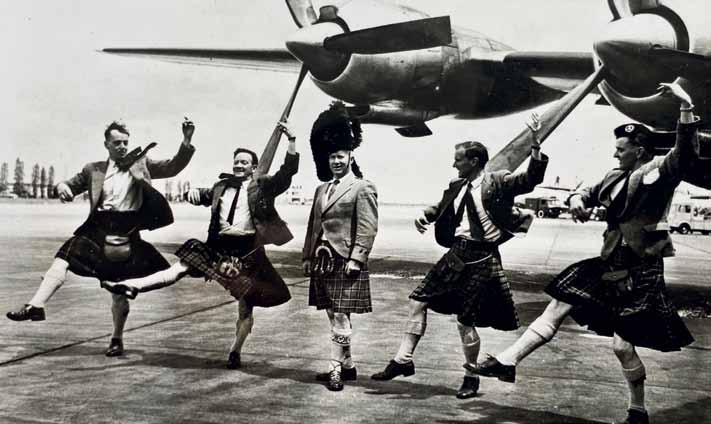
The piper and four of the Clan Hay men arriving at Orly
Loch Lomond and Comin’Thro’ the Rye, Bobby Watson danced a Sword Dance, and the Alistair Hunter Trio played. Along with a piper, it was a real showcase of Scottish culture. In other places, we danced Macdonald of Sleat, then the Fivesome Reel, and after dancing the Double Foursome, we would dance off with a Highland Schottische. Other selections included The Gay Gordons,The Bumpkin,The Ship of Grace, the Threesome Reel, the New Scotland Strathspey, and The Reel of the 51st. If you think about it, 1959 was only 14 years after the end of the war, and cultural visits like this were much more important than they are today when we take foreign travel for granted.

and the team on the visit to

Alastair dancing the Foursome in Sweden. Who were the teachers in Aberdeen Branch when you were young?
They were Lily Hunter and Margaret Anderson, both teachers at Dunfermline College when it was in Aberdeen before it moved to Edinburgh, and Archie Paterson. After them came Lesley Martin and Jean Yates.
You also went abroad with the Society. Yes, I was on the International Team that went to Stockholm. Alastair MacFadyen trained the team, which included quite a few dancers from Glasgow.
You must have met Jean Milligan.
Oh, yes! When I took my preliminary certificate, she told me I would never make a teacher. She wrote me a letter. I will never forget what it said, ‘Mr Reid, your dancing is second to none, but you’ll never be a teacher.’ So that was my gas on a peep! You’d never get away with that now. She used to give teaching certificates to people who had never taken a course. That was the end of any thoughts I had about teaching. My good friend, Johan Maclean, said I should carry on, but I decided
not to. Jean Milligan brought dancing to many people, but there was nothing else to do when I was growing up. After the war, people didn’t have money; it was before the days of television, so going to an evening of country dancing was a very inexpensive thing to do. Halls were full of people of all ages dancing. If you went to the general class in Aberdeen Branch, the hall was full with 8 or 10 sets. Today, we only get numbers like that in our Ceilidh dance class.
And a class of that size has a different feel about it. Yes, absolutely. It’s more sociable. It was one dance after the other! There was little emphasis on technique unless you were in the demonstration class. In the general class you were just dancing socially. Most dancers were there to get some exercise and have a nice, sociable evening all through the winter; they had no interest in demonstrating.
When did you first go to Summer School?
It was in 1964, so I was in my twenties. I thought it was wonderful. My good friend, Frances Gordon, persuaded me to go. She later became the Society Archivist. I have been going ever since. In 1967, I was in a special class for young people taught by Miss Adams. It was a great class. Miss Adams approached Miss Milligan and suggested we provide the demonstration in the Younger Hall. Up to that time, the demonstrations were all danced by teachers. So, she came and had a look at the class and agreed. It was the first year a team of young dancers had danced, and the teachers didn’t like it at all. The team included Alex and Kate Gray, Jean Martin, Bill Zobel, and Gary McIntosh from Elgin. The last time I danced in a Younger Hall demonstration – you will remember it because you were in the team, too – was the year when Mrs Milne of Kinneff came out.
Who were your favourite musicians?
In Aberdeen, we had Annie Shand Scott. She could dirl it up! At the end of the evening, when the dancers were beginning to flag, she would play tunes to lift the whole room. She would look at the floor and say to herself – time to lift this lot up! When she played, your head went up, and your feet danced better. Jennifer Wilson is in the same league. She is excellent. And Muriel More from Glasgow was brilliant. These musicians read the floor. They reacted to what the dancers were doing. Most musicians today really are very good, but Annie Shand Scott was special.
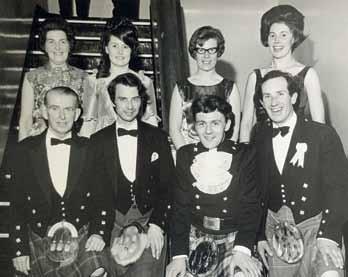
You are a Life Member, aren’t you?
Yes, in the mid-50s, the Society needed money. Until then, the Society had been run from the home of the Secretary, which was a voluntary post. When we appointed a permanent secretary, it was decided we needed premises. 12 Coates Crescent was bought in 1955, and life membership was started to fund the purchase. It was bought for £4,010, and with some refurbishment, the total cost was £6,005. And, of course, it is now worth over two million, a fairly good return, thanks to the life members. That’s why I am happy to continue getting my magazine twice a year. I’m sure most members today don’t know that the life members funded 12 Coates Crescent. And even if some of us are no longer dancing, we still want to keep in touch through the magazine. If the magazine were only digital, we would lose members, no question. I truly love getting my magazine and reading it from cover to cover. I start at the back – to see who has died! The magazine is the only way I can find out what is happening in the Society.
What does the future hold for country dancing?
Well, we need to concentrate our efforts more here in Scotland. It should be in the schools. If everyone learned it in school, you won’t get them to continue when they leave and join the Society, but you will get some.
We don’t know how to get into schools today. It’s a lot more difficult than it used to be.
We need to get into the teacher training colleges. It used to be part of the training of PE teachers, but that stopped. And somehow, we need to persuade boys that this isn’t just for girls. Boys don’t need kilts. I don’t have the answer, but there is no other country where country dancing is part of the culture the way it is here. Here in Aberdeen, we have a very successful ceilidh dance class run by Sheila Bain. The average Scot will know the Dashing White Sergeant but never have heard of The Reel of the 51st. We are publishing too many new dances. They are alright for experienced dancers, but they are not going to bring in new people. John Drewry was a very good friend of mine. He devised two dances for me – the strathspey, The Flower of the Quern, and a jig, The Miller of Clatt. Clatt is a wee village between Alford and Huntly, and my grandfather was the miller. John devised a lot of extremely nice dances, but far too many. I was in the group where he tried out his new dances. There was one occasion when we were doing one of his more complicated dances – we had some women dancing as men – and I had to say, “Stop, John! I don’t know whether I am dancing with a man or a woman.” It turned out I was dancing with a man, so I told him he had to change the dance! It’s quite acceptable today, but not back then. There are just too many dances now.
One final question – what is your favourite dance? Red House. I danced it first in a festival as a child – and we won – and I still like it. It’s a great tune and a simple dance. That’s the kind of dance I like, one where you can really DANCE.
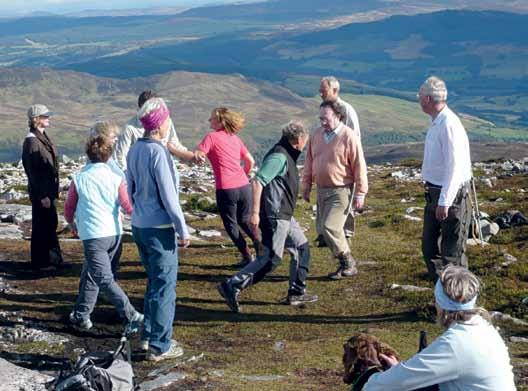
Many country dances take their names from locations throughout Scotland and worldwide. Some years ago, a group of dancers decided to dance in those famous and sometimes challenging locations. John Palfreyman, from Dundee, recounts the origins and successes of this hardy group.

Fifteen years ago, a group of around 25 keen Scottish country dancers set off on a dancing expedition to one of Scotland’s iconic mountains, Schiehallion. In subsequent years, this bit of fun led to the group dancing in unusual venues around Scotland. Why Schiehallion, and why have these dancers become so interested in dancing at various sites around the country? The answer is ‘Extreme Location Dancing’ or, in its gentler guise ‘Location Dancing.’
All those years ago, our dancers, based in Perthshire, Angus and Fife, who practised weekly in Dundee, learned the dance Schiehallion. Our group developed from a dancing group on the frigate Unicorn led by our dancing instructor, Roderick Stewart. At the same time, one of the dancers had the urge to climb a Munro, any Munro. Two friends suggested Schiehallion, and they achieved that goal. You can probably see where this is going now. On the way down the mountain, the three friends came up with the idea of dancing Schiehallion on Schiehallion. They found two or three possible dancing sites, not exactly bowling green flat, but at least the boulders were widely spread. When questioned if they liked the idea, the rest of the dancing group asked ‘why?’ but this soon became ‘how?’ and ‘when?’
There were several problems. First, most of our group were in their late fifties / early sixties, and some had never climbed a mountain. For some, our weekly dancing class was the only way to stay moderately physically fit. Second, in 2009, sound systems did not consist of just a mobile phone plus a small Bluetooth-linked speaker. Third, Schiehallion is a complex dance, and the thought of dancing in walking boots and anoraks in typical Scottish early summer weather seemed more than a little ambitious, foolhardy, or coronary damaging; take your pick.
However, minor difficulties would not get in our way, and training walks were organised over the summer; by mid-September, we felt moderately confident. So, on a sunny Sunday morning, our dancers met at the Braes of Foss carpark, at the foot of the mountain, for a quick briefing session followed by the ascent. We took a CD player, an amplifier, two loudspeakers, a digital camera, a lead acetate car battery, and a set or two of bagpipes in case the technology failed.
The weather looked promising. At Braes of Foss, there was a very light wind, and the skies were blue with just a little mist on the far away summit of Schiehallion. A few hours later, we were on a small grassy plateau a thousand feet below the mountain’s summit, and the fun started. First, an easier dance would be needed to see if anyone would find the conditions too difficult, whether altitude
sickness was likely a problem, whether there were any twisted ankles, etc. No, everything was fine, and we set off to the top.
On the top, our two pipers serenaded the group, and as they played, a hang glider floated by, and the mist lifted. The view was magnificent, a moment to be savoured. Scotland was at its most romantic and beautiful, and our group made it to the summit. We had realised by this time that a dance right on the rocky top of Schiehallion was not feasible. The descent started, and we repeated the dance just a few hundred feet below the summit. Extreme Location Dancing (ELD) had been born.
On the way down, we started to joke about the concept of ELD and the less adventurous Location Dancing (LD), dancing dances in the places they were named after. Ideas flooded in: TheWind on Loch Fyne, Culla Bay, Polharrow Burn,The Duke of Perth,The Bees of Maggieknockater and even, perhaps overly ambitiously, The Corrievreckan (named after the famous whirlpool in the sea just north of Jura). We danced The Corrievreckan on site whilst at sea in a small boat a few years ago. Amazingly, at the time of writing and 15 years on from Schiehallion, our group has now done over 150 dances all around Scotland. Some groups have ventured afield to dance Gothenburg’sWelcome in Gothenburg and The Streets of Milan in Milan. Our most distant dances were the Duke of Perth and Australian Ladies in Perth . . . Australia!
You can view some of our adventures here: https://youtu.be/7Zo3aP55oIs
Our next adventure, well, that’s another story.
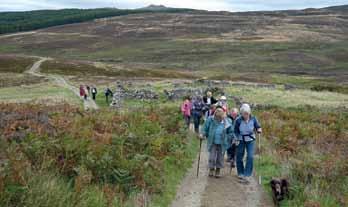
The Research Group has been analysing dances from some of the earliest books to determine if the sources cited are accurate and if the reconstructions fit with what we now know would have been 18th and 19th century standards. Peter Knapman, a member of the group, discusses some of the results and steps to take moving forward.
One who dwells in the past is blind in one eye, but one who ignores the past is blind in both. This is a well-known saying attributed to Alexander Solzhenitsyn. Is the RSCDS at risk of becoming blind in both eyes by not paying sufficient attention to our traditional dances?
But first, what do we mean by the past—1923 or 1723? This article concerns the Society’s early days and its relationship with dances from previous centuries.
During the early years of the Society, the emphasis was exclusively on traditional dances. From 1924 until 1986, the RSCDS published nearly 500 dances, and apart from 45, all were claimed as traditional. Some have an acknowledgement of their source, but many do not. Even where there is a credited source, it is often vague, lacking in detail, and sometimes incorrect. So, where do these dances come from? How accurate are the RSCDS reconstructions? How traditional are our traditional dances, and does it matter? Yes, the origins and sources of our traditional dances should be of interest to all our members.
The Research Group has taken up the task of attempting to establish accurate sources for as many of the traditional dances published by the Society as possible. Although this is a considerable challenge, it is easier today than before the advent of the Internet, as many historical sources have been digitised, making them more accessible.
It has been an interesting and revealing exercise. It has also demonstrated just how dedicated the founders of the Society must have been to search out historic collections. In particular, Mrs. Stewart left in her notebooks some very detailed and accurate copies of historic dances from a wide range of sources. Dances were also contributed by other knowledgeable people, such as Ion Jaimeson and John Duthie, who were prominent in collecting dances and information about dancing in Scotland. Perhaps the most disappointing aspect of this exercise is having to undertake it at all. An organisation that promotes the traditional dances of Scotland and claims that “the descriptions now given are those which research indicates to be the original and correct method of performing each dance” might be expected to have been meticulous in annotating its research. Unfortunately, this has not been the case, and it is also a false assumption. Historic dances inevitably have some degree of uncertainty about them. How do you interpret what are rather sketchy instructions from 300 years ago? What exactly do some of the terms mean? How did people dance 300 years ago?
What have we discovered?
To date, we have identified and scanned sources for over 300 dances. This means that for at least two-thirds of our traditional dances, we can now see the original document used to create the modern reconstruction. This has involved an extensive amount of fascinating work, but there are still gaps, which we continue to try to fill.
One thing that has come to light is that some dances have names different from their historic sources. Sometimes, the difference is small and understandable as it appears to correct a possible spelling error in the historic source – Maxwell’s Rant was published by Rutherford in 1756 as Maxwill’s Rant. Some of the name differences make sourcing the original quite a challenge.
The lack of historical notes by the Society makes it a daunting task to source dances with a name change– to date, we have identified about 20, but I suspect there are a few more!
How traditional are our traditional dances?
This is an interesting question and one that is not straightforward to answer. Many of the dances in the early books were either collected or taken from nineteenth-century ballroom guides. These are, on the whole, straightforward to interpret, making it easy to relate the RSCDS version to the original source. Nineteenth-century country dances should, however, be put in context as dance programmes of this period contained a variety of dances, not just country dances. Quadrilles, couple dances and Scotch reels were included in dance programmes, as well as country dances. Country dances were often considered light relief from the other more challenging dances of the period!
As well as relying on collected sources for dances, the Society explored the eighteenth and early nineteenth-century dance books. Between 1651, when John Playford published his first edition of The Dancing Master, and 1820, when Thomas Wilson published the fourth edition of A Companion to the Ballroom, over 300 country dance books were published. Mrs. Stewart, Miss Milligan and others appear to have searched for copies of many of these books, mostly published in London, in libraries or private collections, to identify dances suitable for publication by the Society.
Alongside the books of country dances, many dance teachers and dancers created manuscripts of the dances they were familiar with. The earliest of these date from the first half of the 18th century and are the earliest sources of country dances written or published in Scotland. They provide an important insight into which dances were being danced in Scotland. The Society has sourced a number of traditional dances from these manuscripts.
We must remember that a reconstruction of a historical dance is just that – a reconstruction. It attempts to interpret written instructions from an earlier age and create a dance that is interesting to today’s dancers. Often, more than one interpretation is possible. While many RSCDS reconstructions are faithful to the original source, others include what can only be described as taking imaginative liberties. Although there is nothing intrinsically wrong with an imaginative reconstruction, we should always be open and honest about how we arrived at the reconstruction. Unfortunately, in the past, the Society has not explained how it has arrived at the published version of some of our dances. I think this is to our detriment.
When we dance a traditional dance, do you wonder how close it is to how people would have danced it in the past? We know that tempos may have changed and formations possibly tweaked a bit, but we are dancing a traditional dance – aren’t we? Well, that may be true for many of our dances, but not by any means for all of our traditional dances. The Society has published strathspeys that were never strathspeys, cut formations out of dances, added formations into others, turned reels into jigs and jigs into reels and both jigs and reels into strathspeys. A surprising number of our historic dances would
Continued on page 16 w
originally have been danced to 9/8 jigs – not now! With a few notable exceptions, RSCDS dances in 3/4 tempo are rare. Historic dances often have a strong relationship between the tune and the dance, and if the modern interpretation changes the length of the dance, this relationship is lost. The Society has published a number of dances in which the length of the modern dance is different from its historic source—32 bars become 40 bars, 64 bars become 48 bars, or sometimes 40 bars. Not all these RSCDS adaptations have been successful!
One of the reasons for undertaking this research was an awareness that many of the traditional dances published by the Society do not appear on programmes. Why not? There are many reasons, such as being too easy, too similar, not interesting to the modern dancer, or they include unusual or difficult-to-execute formations, etc. One of the tasks we have set ourselves is to review some of these ‘undanced traditional dances’ to see if an alternative reconstruction could be made that might be more appealing to today’s Scottish country dancers. It would be remiss in an article about interpreting traditional dances not to acknowledge that many traditional dances published by the Society have been reconstructed in a manner that has stood the test of time and have become classics.
The Society prides itself on being a forward-looking, living tradition. Devising dances with new formations has been one of the hallmarks of the last 40 years or so. However, if we only look forward and ignore the past, we risk becoming remote and potentially one-dimensional. Exploring older dances by trying to understand and interpret the source material directly can be an enlightening experience. This can cast a new light on familiar formations and their relationship with the music – looking back and understanding the past is just as important as creating a living tradition.

GlasgowLassies-WalshCalCDVolIIpartI(1748)-NLS

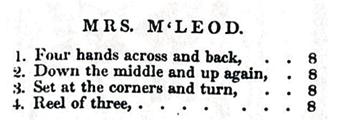


Rod Downey, a teacher and dancer in Wellington, New Zealand, shares the enjoyment of the afternoon held in April 2024. More information about the event is available at https://wellingtonscd.org.nz/
In 2023, the Wellington RSCDS Region Committee held a programme of Early Wellington Region Dances to celebrate the Society’s centenary. In 2024, we decided to hold a workshop exploring of early RSCDS dances in the same spirit. Since the Society’s Book 1 appeared in 1924, 2024 is the centenary of its publication.
The committee agreed upon the early dances chosen from Books 1-5, which appeared before 1930. An afternoon only about Book 1 would have included no strathspeys and a very limited set of formations; thus, we broadened our scope to include a wider range of historical RSCDS dances. I was tasked with leading the event, as I love those old dances.
It is interesting to see what people did in the early books and wonder if they would be popular today.
Books 1-5 contain 60 dances. From these 60, I selected 13 based on interest and danceability. The group managed 10 in the afternoon. I included at least one dance from each of Books 1-5. I tried to avoid dances we commonly do, at least for the most part. Thus, no Petronella, Flowers of Edinburgh, etc. I also tried to keep a variety of formations, which was not so easy in the early books. For example, seven of the 12 dances in Book 1 finish with a poussette. How times have changed! For several years, knowing ‘down the middle and up, poussette’ meant you knew half of most dances! Would today’s dancers like a programme where most dances finished with a poussette?
I excluded some of the dances as they are genuinely challenging to dance and, I felt, were more like technical exercises. This includes The Falkland Beauty, one among several dances, such as Saint Patrick’s Day, which were probably wrongly reconstructed. For others, I chose less familiar dances with similar elements. For example, instead of Strip the Willow, I included an alternative dance with the running step, The Haymakers. Instead of Glasgow Highlanders, I chose Lady Macintosh’s Rant, which does have an unusual and similar starting position and is not commonly done. However, it is
an adapted `triple minor’ rather than a `double minor.’ (Ed. In English country dance terminology, where dances are still formed ‘longwise for as many as will,’ a double (duple) minor is a two-couple dance where every second couple in the line begins. Similarly, in a triple minor, every third couple begins.)
Music: Our musicians, Lynne Scott and Sam Berkahn, came to the party. They made up the sets from a lot of old tunes, mainly from the 18th Century. They played several of the dances using only instruments available in the mid-18th century: the fiddle and cello. This task involved the significant arrangement of music for the cello. The second tune of their set for The Haughs of Cromdale was Mrs McInroy of Lude, written by Joseph Lowe The musicians’ task was not easy as many of these dances were not commonly done and needed new sets, especially the 28-bar Princess Royal
SCD Evolution : My wife Kristin and I remember dancing in Cambridge (UK) with the Capriol Dancers, who dance historical early dances and performed many demonstrations. (We found it quite humbling and challenging going back to being beginners and doing steps that resembled those we use in SCD but were not the same.) We talked to this group about older forms of dance. They said one of the main problems was interpreting how dances and steps were performed so long ago. They reconstructed these from descriptions of dances handed down from the 17th and 18th centuries. Our founders, particularly Miss Milligan and Mrs Stewart, put a lot of effort into dance and music reconstruction. Many of the old dances were not in sets but in long lines, and the music would have an instruction such as: ‘longwise for as many as will.’ The Society decided to have all dances adapted into sets, except some round-the-room dances.
Some References: One excellent history of how SCD developed in its current RSCDS form is Hugh Foss’s Evolution of Scottish Country Dancing.’ (1973). Foss relates how the RSCDS style of Scottish Country Dancing evolved from the dances in the famous multi-edition books by John Playford, The Compleat
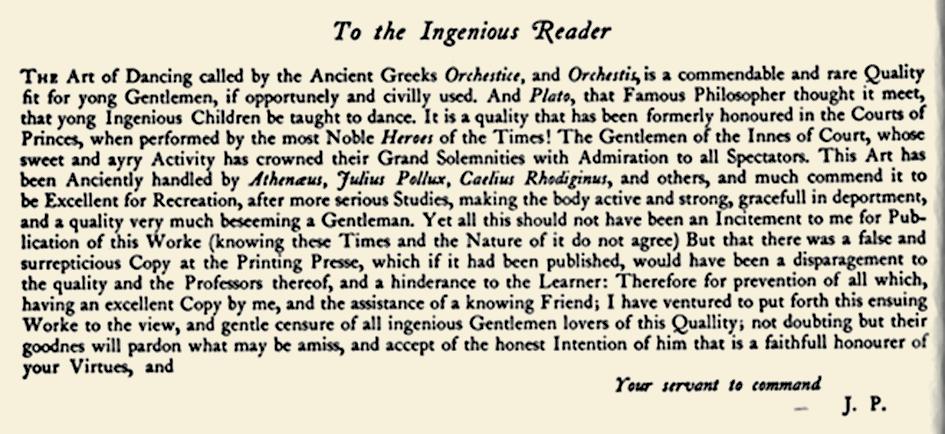
Playford quote.
Continued on page 18 w
Dancing Master,’ 1651+. Foss remarks, “Miss Milligan and Mrs Stewart got their steps by demonstration and word of mouth from old dancers, so they would probably be of the style of, say, 1860-80.”
Reconstruction of the Poussette: Many early dances finish with a poussette. ‘Old Time’ ballroom dances such as St Bernard’s Waltz often finish with four bars of waltz/rotary chasse/polka turns. In the early dances, whatever the poussette was at the time apparently served a similar dance-ending role.
According to Foss, the current RSCDS version of a poussette is based on their interpretation of the 1790 Ballantyne manuscript. The book A Complete Guide to Scottish Country Dancing by Allie Anderson and John Duthie (1931) talks about two versions of the poussette, one of which is ‘popular in the Borders’ (I used a version of this alternative form in my dance Borders Traditional. In this version the men begin on their right foot.) Many old manuscripts and interpretations exist, mainly where RSCDS dances evolved from English Country Dances. For example, in the 1809 English Country Dance version of The Triumph, the well-known author Cecil Sharp describes the poussette as “Partners meet, engage in waltz fashion, and dance round in a small circle between the lines of the General Set. At the beginning of the last bar, they disengage, return to places, and bow.’’
Limited Formations: Nowadays, we have many formations in our dance form. Some have suggested too many. This was not so true in the early dances, and ‘traditional core’ formations were quite common. For example, Foss remarks, “In books 1-16, there are 171 progressive dances…there are 53 down the
middle and ups, 37 poussettes, 30 rights and lefts, 28 set to and turn corners, and so on.”
The Day: We danced Light and Airy, The Triumph, Lady MacIntosh’s Rant, Rory O’More, The Haughs O’ Cromdale, The Princess Royal, The Haymakers, The Duke of Hamilton’s Reel, The Merry Dancers, and Dumbarton Drums. I have very old versions of some RSCDS books with differing versions of some of these dances. For example, Rory O’More has the first couple dancing down the middle and then retiring backwards, which I asked the dancers to do. I also had the dancers use elbow grip on turn corners and partner through Light and Airy the second time, discussing how this was quite common in the early 20th Century. I also suggested setting to and turning corners using skip change for the formation in The Merry Dancers. This allowed me to discuss the differing opinions of Miss Allie Anderson and Miss Milligan about how to dance this formation. I also discussed the many versions of TheTriumph.
All of the dances were highly enjoyable and had their own little quirks. The day was a real success, but it was noticeable that people got rather tired. Those old dances have great tunes but are genuinely vigorous. I recommend giving them a go! I finish with a quote (with 17th Century use of the alternative ‘long s’) below about the Art of Dancing from the first edition of Playford (1651)
“The Art of Dancing called by the Ancient Greeks Orchestice is a commendable and Rare Quality fit for Young Gentlemen, if opportunely and civilly ufed. And Plato, that Famous Philofopher thought it meet, that young Ingenious Children be taught to dance”.
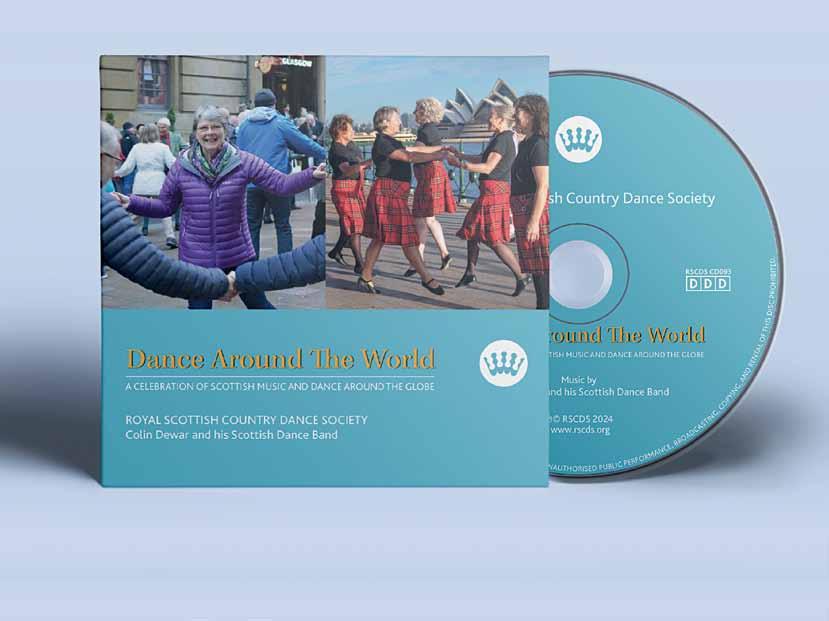
By Fiona Grant and Ronald Currie, with thanks to James Hill, Margaret Lambourne, Pia Walker, Jan Jones. Photos from Martina Mueller-Franz, Chris Harris, and Andrea Boccafogli.
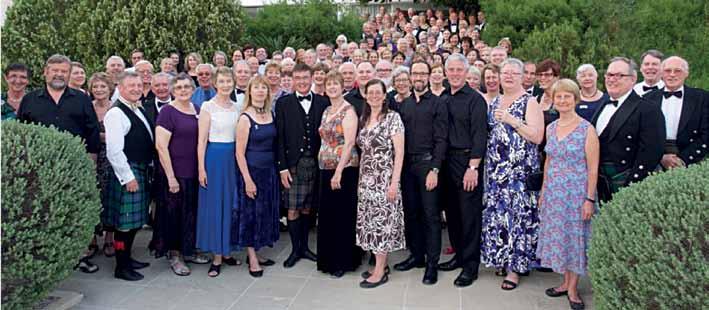
The RSCDS International Branch exists to provide friendship and support to Scottish country dancers who do not live near a local branch and would otherwise have no voice within the Society. Many other dancers join the IB as a second branch to meet and keep in touch with far-flung dancers, raise funds, and offer hospitality to isolated dancers who wish to attend workshops and teaching courses. This distinctive branch reaches its 20th anniversary in 2024, and its idiosyncratic start and success in encouraging small dance groups worldwide to share in the fun of dancing together is celebrated below.
Just over 20 years ago, major changes to the management of the RSCDS were implemented. The old Executive Council, which had consisted of one representative from each branch, was replaced at the AGM of 2002 with a Management Board of 15 elected members. The new constitution stated that the legal ‘members’ of the Society were the branches, and Society members were represented by their branch delegates at the Society AGM. But there was one group of members with no branch and no representation – the so-called Headquarters members – members who had joined the Society directly, not
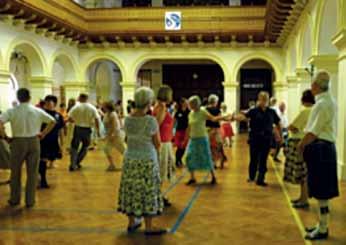
through a branch. The advice from the Inland Revenue at the time was that we could not have members who had no voice.
At the same time, various people were discussing the benefits of forming an international association to bring together geographically dispersed people. People who were remote from local branches either joined as HQ members or not at all. Many of those who joined HQ did not feel part of an organisation that considered their interests.
When a request was put to the Management Board to approve an international association the planets began to align. It was recognised that both issues - the lack of representation and the lack of a place to belong - could be solved by setting up a new branch. At the April 2004 Management Board Meeting, the motion that “The Management Board allow the possibility of the formation of an ‘International Association’ from current HQ members” was agreed. It was also agreed that all HQ members would be asked to choose whether to join the new international branch, another existing branch, or to remain without representation as a member through the RSCDS office. The Management Board then agreed that there would be no new HQ members. All new members would be directed to their nearest or International Branch. It was later realised that some people preferred HQ membership despite the lack of representation, and this option was maintained.
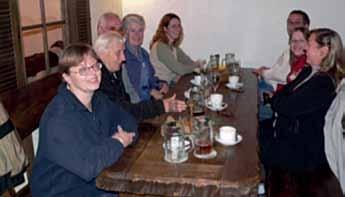
The International Branch (IB) was established in 2004. The first branch committee consisted of Stephanie Robertson, Pia Walker, and Margaret Lambourne. Bernie Hewitt and Johan Berg joined the committee soon after. Susi Mayr provided the link between the IB committee and the Management Board.
In February 2005, the branch’s membership was 35 in 9 countries, but membership grew quickly. By the time of the Branch’s 10th anniversary, there were 250 members in 25 countries. There are now 483 members: for 204 of them, the IB is their main branch and another 279 support the branch’s work through additional membership. We dance in 32 different countries around the world. Although most are dancers, several accomplished SCD musicians are also members of the Branch.
To begin with, most branch members met in person at other dance events, such as Summer School in St Andrews and the Rechberg, Luxembourg and Brussels dance workshops. We had a quarterly newsletter, which Bernie produced, which provided information and constructive advice and was spread by hand, post, and email. This provided great impetus to membership growth as many branches did not do this at the time, and it was important for our members to keep in touch with each other, and find out what was happening in the wider dancing world and at 12 Coates Crescent. At dance events, we hosted drinks and nibbles parties for branch members and encouraged others to join us.
In 2007, after Pia had been over to teach, we decided to hold a weekend in Tallinn, Estonia, to encourage recruitment to the local group. We had a fantastic weekend that was fully booked. In addition, a few days of tourism in the local area were organised. The teachers were Jessie Stuart, Susi Mayr, and Patrick Chamoin, with Bernie Hewitt, Andrew Lyons, James Gray, and John White as musicians.
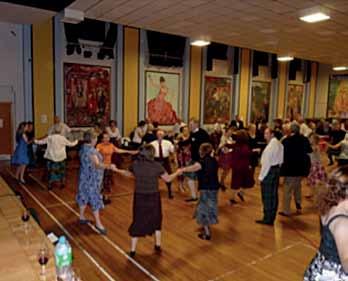
This was the first of many successful international events: Dunfermline (Scotland), Prague (Czechia), Killarney (Éire), Menthon St Bernard (France), Copenhagen (Denmark), Paphos (Cyprus), Utrecht (Netherlands), and Civitanova Marche (Italy). Oslo (Norway) is fully booked for September 2024. We try to organise an event every two years in a different place aiming to offer a small group the chance to experience good teachers and musicians which they would not be able to afford on their

own. We bring the band, teachers and a hall full of dancers - an unforgettable experience for some dancers whose regular class might not have more than one or two sets.
Susi Mayr
Who was this unusual person? She was an Austrian who spoke better English than many native English speakers. She didn’t tolerate fools gladly and had no time for pretentious people but was fiercely loyal to her friends. Susi was an excellent teacher and dancer of both country and step dancing. She was a founder of the Vienna Branch and the driving force behind the formation of the International Branch.
The Susi Mayr Fund was established in her memory to give support to groups or individuals whom the IB committee believes should be given assistance in furthering the aims of the International Branch and Scottish country dancing. Any surplus made annually by the branch is donated to the Fund, and together with generous donations from many members, it has been possible to sponsor dancers, teachers, and musicians to promote the enjoyment of SCD in many small dance groups. For example, awards have enabled members to train as teachers, and travel costs have been met for musicians and teachers to visit small dance groups. 59 awards have been made since April 2014, totalling £35,000.
The development of electronic communication has transformed contact between members of the International Branch over the last few years. Chris Harris has done a phenomenal job keeping the website updated, easily navigated, and informative. His online forms that allow members to enrol for events and pay for membership work seamlessly in more than one currency. His masterful management of the annual online AGM each December is admirable.
The committee meets on Zoom to run the branch efficiently. The online AGM lasts about a week, so everyone can take part wherever they live. Positions on the branch and RSCDS committees are voted on by email so that all members can participate in running the branch and RSCDS.
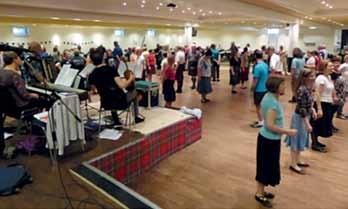
The quarterly newsletter continues to be published. Editors Harry Andrews and Jan Jones are always pleased to hear news from small local groups and individuals. The IB photo is a regular shout-out at many dance events all over the world and features prominently in reports in the IB Newsletter. Members can also read about future dance events and dates—it is quite likely that other IB members will be attending these, too.
But we should not be complacent. We are looking to develop further our relationship with the RSCDS Youth Branch, which also attracts members worldwide. We hope that the natural progression for their members after age 35 will be to join the IB! To facilitate this, Youth Branch members can join the IB free of charge, so they can already feel part of the wider community. There have been some recent joint activities, and both branches are keen to increase cooperation.
All IB events have been well supported, and consideration is being given to holding smaller events in the years between the major events. This should enable more people in different countries to enjoy dancing in larger numbers, to live music provided by excellent musicians. The Branch is currently exploring the possibility of an experiment in Crete next year, and arrangements for the 2026 event in Japan are progressing. Although IB events are open to all, priority is given to branch members, so there is an incentive to join those who enjoy the experience of dancing in and visiting other countries and meeting people with a shared interest in SCD. The Branch is always open to suggestions from members for places or themes for events and for any initiatives that will further enhance the members’ experience.
The vision of the IB’s founders has become a reality: to enable dancers remote from other branches to feel connected and to support the development of SCD across the globe.
From small beginnings 20 years ago, the Branch has grown in numbers and provided financial support to dancers and musicians worldwide to develop SCD in their local areas. Additionally, the Branch has hosted events that have enabled many people to experience the enjoyment of dancing with lots of other people to live music for the first time.
The growth and enthusiasm in countries that have more recently discovered the enjoyment of SCD suggests that there is scope for the IB to continue to increase its membership and support isolated dancers and small SCD groups. IB members have an infectious enthusiasm for SCD, which they bring to many events worldwide, swelling numbers and adding to the fun.
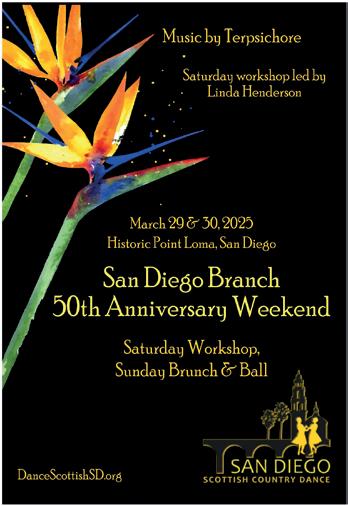
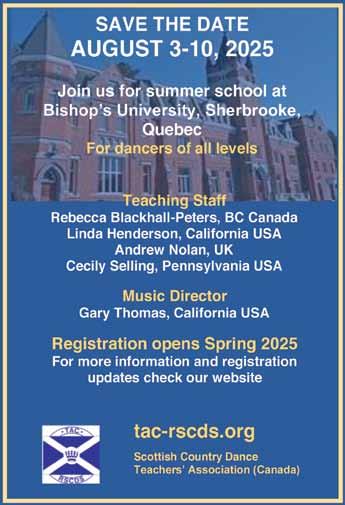
All branches and affiliated groups are invited to send in their news (maximum 200 words) to Caroline Brockbank caroline@ceilidhkids.com
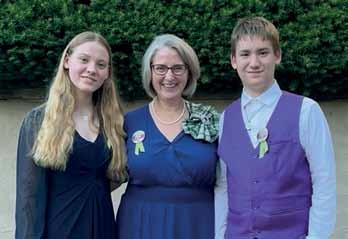
The 13th annual Midwest Scottish Weekend returned to Wayland Academy in Beaver Dam, Wisconsin, 7-9 June 2024. Participants said, “This was a delightful event; we had a wonderful time. We appreciate all the effort that went into creating a fun and educational weekend.”
Our residential workshop featured classes and events led by Arthur McNair and Jennifer Reiner, who participants thought were outstanding. Emphasising how the social aspect of dancing improves the whole experience, their communication and sense of humour were excellent. The trio Terpsichore musicians were champion fiddler Elke Baker, expert pianist Liz Donaldson, and versatile bassist and cellist Ralph Gordon. Terpsichore unquestionably motivated our dancers with inspired and nuanced music.
A new family of dancers had this to say: “What a great way to kick off the summer for our family! My teenagers and I first set foot in a Scottish dance set nine months ago. We have enjoyed every bit of the adventure since then… We had no idea how sore our feet and legs would be by the end or how many new friends and fun stories we would come away with. We’re already planning our ceilidh act (now that we finally know what that is) and will certainly be back again next year.”
Diana Hankes
Another SCD weekend up in the French Alps
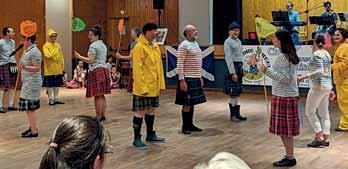
Dancers attending the Méaudre Reel annual SCD weekend.
On 1&2 June, Méaudre Reel organised its annual SCD weekend. Méaudre, a little village 1,000 metres high in the mountains, was invaded by about 70 dancers wearing different tartans. The team had chosen a European face for this special event: David Hall (London Branch) and Florence Burgy (Geneva SCD Club) were the teachers, and lovely music was played by Benoît Gibson and Tomas Goncalves (Lisbon).
After dancing all Saturday in workshops (SCD classes by level, Children’s class and Highland), the dancers were offered a demo by the Méaudre Reel dancers. Thirteen Méaudre Reel dancers are going to Brittany for the third time this summer. Port-Louis is about 10 hours’ drive away; a real expedition going dancing ‘up north’! The Méaudre Reel dancers adopted a special dress to dance A Black and White Flag, devised for this tour. The Breton stripes didn’t match the tartan squares, the fishing boots were not that convenient for Pas de Basque, and all the ladies were dancing with fishing nets, but in the end, the dancers made a funny and nicely danced show. See you next year for a new Méaudre Reel surprise!
Sophie Marchand
Shaftesbury and East Knoyle SCD Group
In April, on a beautifully bright and sunny day, we held an Anniversary Dance in the delightful setting of the Durweston Village Hall, with a lovely buffet lunch. It was to celebrate 100 years of the RSCDS and 55 years of dancing for the Shaftesbury and East Knoyle SCD club. We welcomed around 60 dancers

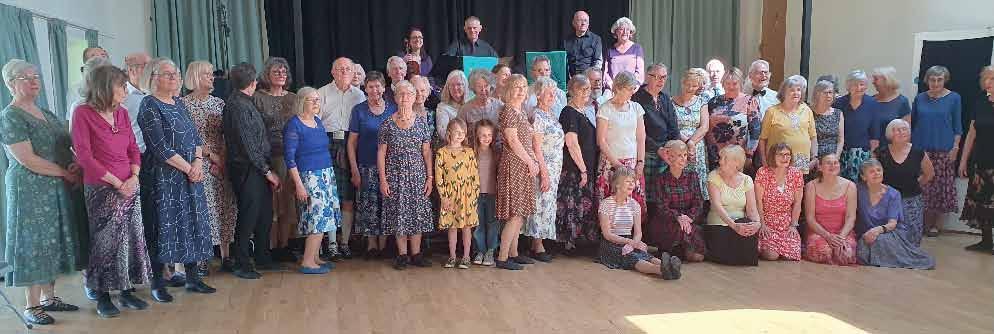
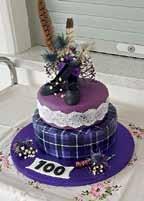
A very splendid cake, indeed!
Shaftesbury centenary dancers and band from several clubs in Dorset, Somerset, Wiltshire, and Hampshire, including a few others from even further afield. We were delighted to have the brilliant four-piece Craigellachie Band playing for us, with a great selection of tunes for our programme. We had a wonderful time with friendship, food, music, and dancing to ensure everyone had a happy and memorable time. And, of course, we had a cake - and what a splendid one it was. We were all astounded by the skill of our club member who made it.
NickyTyson
Good News at Tokai Branch AGM
Tokai Branch is one of three branches in Japan. At the AGM this year, two splendid pieces of news were officially announced. Firstly, a Branch Award presentation after a long time. In recognition of many years of great contributions in promoting Scottish country dancing, Sachiko Masumoto was given the Branch Award. We took a photo of her and the award, signed by RSCDS Chair William Williamson and Branch Chair Masahiro Kondo on the day. (Photo, front row centre)
This year, we are so happy to welcome our first youth member, a 14-year-old junior high school student! She is the granddaughter of one of our long-time members, who started dancing after seeing her grandmother having fun. She joined in the branch class after the AGM, and we enjoyed dancing with her. (Photo, third from the right in the front row). We are so
happy to be able to dance together with people of all ages and genders for a long time to come
Yoko Akamatsu
Vienna Anniversary Weekend
Vienna Branch celebrated its 35th anniversary at Whitsun (17-20 May) with a weekend course of workshops and dances. More than 80 dancers from a dozen different countries were joined by members of the Branch for the welcome dance on Friday and by friends from Budapest for the Saturday social and the Sunday ball. On each occasion, we enjoyed superb music from James Gray and Matthias Rank, who provided an unforgettable treat at the Ball when they adapted tunes by Johann Strauss for The Ambassadors’ Reel.
Gary Coull’s teaching was inspirational, and his light-hearted approach kept us all in good spirits—even when we had to dance double triangles early on Monday morning! Silke Grosholz’s excellent playing complemented the teaching perfectly. On Saturday afternoon, a small group toured the Fuchsvilla with Nicole Pieper, while others joined a step class led by Kate Gentles; on Sunday afternoon, Felix Hamelbeck led a large party on a city walk.
Bexi Wepner brilliantly organised the weekend. Although numbers were lower than anticipated, the dance floor was pleasantly full but never overcrowded, and the warm, friendly atmosphere made it an extremely enjoyable experience.
Tim Bolton-Maggs
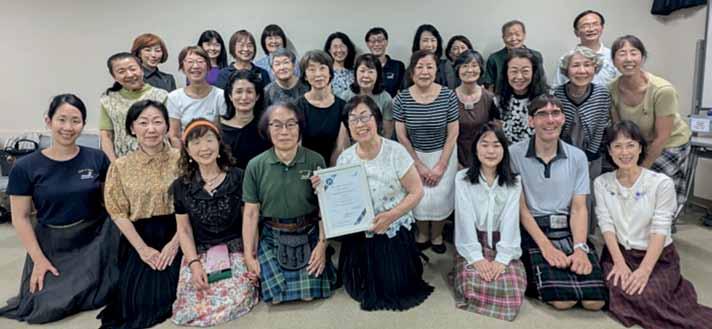
Dr. Heather Blasdale-Clarke is a Cultural Historian researching in Australia. This is a shortened version of the author’s article on John Piper from her fascinating website on historical dance in Australia, www.historicaldance.au.
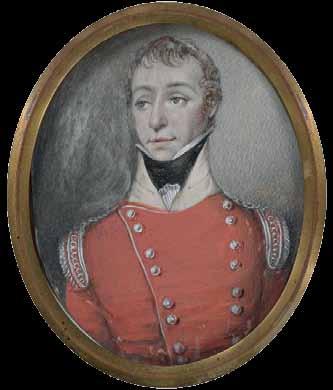
Captain John Piper loved to dance. A Scotsman from Ayrshire, he became a leading figure in early colonial Australia, where he created an elegant and luxuriant lifestyle with music and dancing at its heart.
John hailed from the small town of Maybole, Ayrshire, in the southwest of Scotland. His parents kept the King’s Arms Hotel in the High Street where he was born on 8 August 1774. As a stagecoach inn, it was a popular destination for travellers journeying between Glasgow and Ireland and a favourite meeting place for locals. John was 12 years old when the famous Scottish poet, Robert Burns, spent a convivial evening at the inn. Throughout his life, John remained proud of his Scottish heritage and a devoted admirer of Burns.
In 1791, when John was 16, his uncle bought him a commission as an ensign in the newly formed New South Wales Corps. When John arrived in London to enter the service, his uncle, with the consent of the regimental major, arranged for the young man to attend an academy to “learn geography, speak French, learn arithmetic and fencing, and gain the opportunity to see the dancing”. In an early glimpse of John’s character, he wrote to his sister, “But my uncle told the Academian that I was the best dancer in London.”
Piper arrived with his regiment in Sydney Town in 1792 when the fledgling colony had been in existence for only four years. He immediately became part of the social life centred around Government House, his charming and easy-going nature ensuring his popularity. Within three years, he was promoted to lieutenant, rising to the rank of captain in 1806.
Piper served two periods on Norfolk Island (Ed., thepenalcolony of Norfolk Island), becoming the acting commandant in 1804. It is thought that it was while he was the commandant on the island that he met Mary Ann Shears, daughter of two First Fleet
convicts. Together, they formed a life-long devotion, eventually marrying in 1816. Remarkably, despite Mary Ann’s convict background, she became widely accepted as one of the elite of colonial society. Perhaps this was due to Piper’s extraordinarily gregarious and charming nature - he was prepared to welcome nearly everyone into his flamboyant social life.
The captain’s place in society was elevated enormously in 1814 when he became the Naval Officer of the Port of Sydney. This position made him one of the most highly paid men in the colony in which he was already a leading socialite, enabling him to expand his hospitality even further. As the Harbour Master, he was the first person (apart from the pilot) to board incoming ships, taking fresh supplies, welcoming the captains and passengers, and bestowing invitations to his entertainments.
Given his new wealth, Piper decided it was time to move from the humble timber house that was the official residence of the Naval Office and take advantage of the land granted to him as a former army officer. Inspired by the beautiful villas he had seen around what became Regent’s Park in London, he engaged the convict architect Francis Greenway to design a magnificent mansion where he could host his grand diversions with style. It even incorporated a splendid ballroom created in the shape of a St Andrew’s Cross with a domed ceiling. The mansion became the centre of social life in Sydney, and it seems nearly every event included dancing - picnics, dinners, fetes, and balls- and delightful entertainment that could last for three days. For the Captain, dancing was of paramount importance, especially considering his Scottish heritage.
As one of the elite of colonial society, Piper was allowed a large number of convict workers (nearly 100). These were employed in all the positions necessary for maintaining a stately home: gardeners, domestic servants, footmen, coachmen, etc. In addition, he cultivated a band of musicians who played Scottish tunes as well as the fashionable dance music of the day. He regularly employed a Highland piper to play the Scottish music dear to his heart. He may have used his position as Harbour Master to give him first choice in selecting convicts with musical talents to join this band.
l “His house was approached by boat, a Scotch piper in full Highland dress was on board to play all the time for the guests. It was usual for him to have the piper in attendance”.
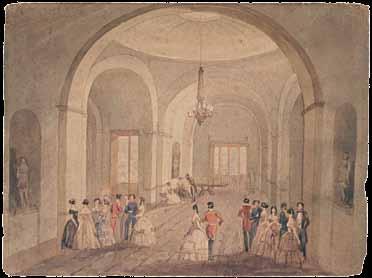

l “Piper ferried his guests to the point in a barge, where they were welcomed by liveried servants playing gaily on musical instruments”.
l “He keeps a band of music and they have quadrilles every evening under the spacious verandah”.
The band played for entertainments at Henrietta Villa and was also made available for civil and private functions. A ball given by Sir John Jamison was one such occasion:
l “The Ball and Supper, given by Sir JOHN JAMISON on the evening of Thursday last, was of the most fascinating and splendid description. The ball-room was fancifully fittedup for the occasion. The Company flocked in from 8 to 9: the carriages were rolling rapidly down our streets between those hours. Captain PIPER, with his usual zeal in these cases, had his own Band in attendance upon the noble Host. Dancing, consisting of country dances, quadrilles, and Spanish waltzes, presently commenced, and was maintained with the utmost animation...”
Over the years, many ballrooms in Sydney were graced by the music of Piper’s own band and the resident regimental band. At the Turf Club Ball in 1825:
l “The Dancing commenced at 9 o’clock; after Supper at 12; after which Dancing was resumed, and kept up till day-light. The band of the 40th, assisted by Captain PIPER’s Band, played most enchantingly during the evening.”
In 1826, Piper’s band provided the music for a special celebration at the grand home of William Cox. Piper’s cousin Elizabeth had married William Cox (junior), a member of an elite local family, and the two families often gave entertainments for the colonial gentry.
l “Clarendon, near Windsor, the hospitable mansion of Captain Cox, has been the scene of gaiety and festivity, during the past week; three of the infant grandchildren of the worthy proprietor were to be admitted within the pale of the church of England; and a numerous party were congregated together on the occasion. Captain Piper’s Scottish band arrived from Sydney in order to enliven the scene, and add another species of harmony to the other hilarities of the scene.”
Captain Piper’s career ended when the new governor, Sir Ralph Darling, arrived and ordered an inquiry into the state of the Naval Office. It was found Piper had seriously mismanaged the collection of custom duties— not dishonestly, but simply through leniency and carelessness. It was well known that Piper was more inclined to entertain his debtors to lunch at the Villa rather than harass them for payment!
With his riches depleted, Piper took his family to live in his remaining property, Alloway Bank, situated four miles from Bathurst. As they left Sydney and travelled over the Blue Mountains, their passage was again accompanied by music:
l “CAPTAIN PIPER, the promoter of harmony and good fellowship whereever he goes, is at last firmly fixed on his estate at Bathurst. His bugles, which accompanied the last wagon of furniture, struck up as they were passing the Blue Mountains, the lively tune of “Over the hills and far away,” to the great delight of the drivers of all the carts and drays they met with on the road.”
Bathurst had been settled a little over 10 years earlier and now was home to several respectable families who formed the local landed gentry. Many of these were ex-army officers who had been granted large estates of 2,000 acres and were already well known to the Pipers. The Captain and his family were immediately welcomed by their neighbours and friends, and entered a new version of their genteel social life.
But, Bathurst!Thy groves and thy hills, and thy vales
With the sounds of his glees are now ringing; ThyAlloway crowns him her bountiful laird, While shepherds his welcome are singing.
Piper’s original home in Scotland was near the village of Alloway, famous as the birthplace of Robert Burns. Alloway House was a popular Scottish tune, and the captain named his new house Alloway Bank.
Despite his change in circumstances, Piper continued to keep a band. One visitor recalled his surprise at hearing the band:
l “I spent an afternoon at Captain Piper’s during my visit to Bathurst .... when we were just about taking leave,... a musical band, consisting entirely of a few of the farm-servants, who had each learned to play on some musical instrument, struck up a lively Scottish air under the verandah, which, I confess, was, on my own part at least, equally unexpected and animating. . .”
Dancing remained a favourite pastime for Piper and his family. As his daughter Ann noted in her diary, “whenever there were visitors, there was music for dancing.” With a regiment stationed at Bathurst, there were frequent invitations to dances and balls. In 1828, a ball and supper in honour of Dr John Harris was held at Government House, Bathurst, with music supplied by Piper’s band.
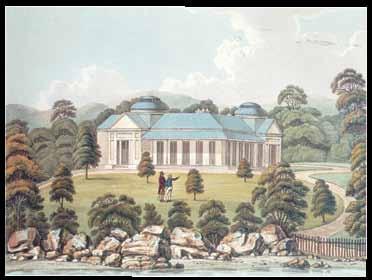
l “On the following Tuesday government-house was in a bustle, from the vast preparations a going on therein for a ball and supper, “a propos” to welcome the venerable Doctor. On that evening all the “beauty and fashion” of the county of Roxburgh graced the mansion, and the enlivening band of the worthy Captain Piper kept them on the light fantastic toe, till the morning sun had nearly fired the eastern plains . . .”
It was not uncommon for dancing to go on throughout the night, as an account of the subscription ball given at the Bathurst Races demonstrates:
l “...a subscription ball took place at Mr. Dillon’s Inn, given by the gentlemen of Bathurst and its vicinity, at which all the elite of the district were present; quadrilles commenced at nine o’clock, the rooms were elegantly decorated; Captain Piper’s band was in attendance, and surpassed even its accustomed good style of performance. At one o’clock, the company retired to partake of a splendid supper, which was elegantly laid out and consisted of all the delicacies of the season. After supper, dancing was resumed with great spirit, and kept up until the dawn of day, when the company separated, highly delighted with the evening’s amusements.”
Both in Sydney and in Bathurst, Piper’s popularity extended across social barriers, and he earned a reputation for philanthropy among all classes by giving generous supportto the Benevolent Fund, the Bible Society, and various churches.
A man of a thousand, for frolic and fun. And merry old England’s gaiety, A friend to the poor, as well as the rich To the clergy, as well as the laiety.
In 1838, after again experiencing financial difficulties, Piper sold Alloway Bank, and the family moved to Westbourne, a modest farmhouse overlooking the Macquarie River. Captain Piper died in 1851, and Mary Ann died in 1878; both were laid to rest in the Bathurst cemetery.
Dancing was a fundamental element in Piper’s life, and as his contemporaries said, “he always entertained his friends right royally.” Among the distinguished early pioneers, few were better known and none more popular than Captain John Piper - remembered as “a typical, genial Scotchman, one of Nature’s gentlemen and the Prince of Australia.”
All the quotations in this article are from publications and letters of the time: for details, see the website: www.historicaldance.au
The Merry Lads of Ayr from Preston’s 24 Country Dances for 1803.

A popular dance in Captain Piper’s day was The Merry Lads of Ayr. As was usually the case when writing about balls and dances at the time, although country dances were noted as being danced, the names of the actual dances were rarely mentioned. Given Captain Piper’s birthplace and his enthusiasm for Scottish heritage, it is likely The Merry Lads of Ayr was danced in his grand ballroom. The dance remained current in Scotland throughout the nineteenth century and in 1924, it was included in the Scottish Country Dance Society’s first publication.

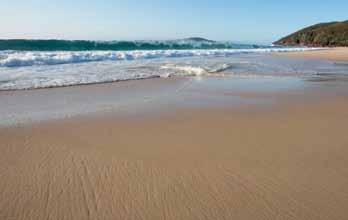


Royal Scottish Country Dance Society Hunter Valley Branch Inc. 48th Australian Winter School 5th to 12th July 2025
We welcome you all to a week of dancing, music, fun and fitness in the Hunter Valley of New South Wales Australia. The School will be held at the Wyndham Ramada Resort in Shoal Bay, in the Port Stephens area just north of Newcastle. Featuring international and local teachers and musicians: Teaching staff
• Rachel Shankland – Scotland • Andrea Wells – NZ
• Gaye & Damon Collin – NZ • Diana Hastie – Aus
• Debbie Baker – Aus • Simone Fox – Aus Musicians
• The David Oswald Band – Scotland – Comprising David Oswald, Alasdair Macleod & Gillian Stevenson
• Chris Duncan & Catherine Strutt
• James Gastineau-Hills
Come and enjoy a wonderful week in the blue water wonderland of Port Stephens. Registrations now open. Save the date!
Organiser: Marney Wilson

Email: dancers4hvws2025@gmail.com
Website: ausrscdswinterschool.weebly.com
Postal address: PO Box 97. Adamstown. NSW. 2289. Australia
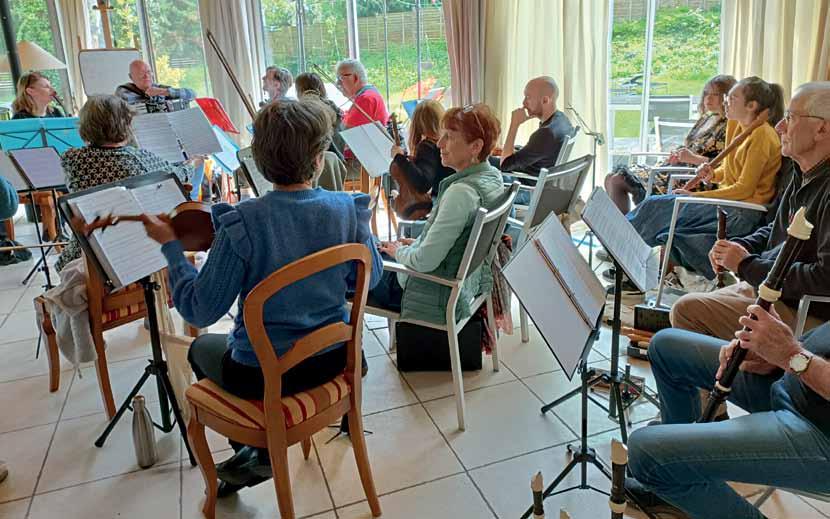
By Diana Sarran, Lyon France
Imagine touring the French Alps by car or coach, bowling along through Annecy and along the lakeside heading east, when through the open window what do you hear? The music for J.B. Milne? No, can’t be! If you passed some minutes later, it might be a lovely jig by MacIntosh. But it’s not your imagination or wishful thinking. Behind a high fence, set in a garden with a stream running through it, sits an amazing house and inside are 14 local musicians working hard to learn the Scottish idiom. They have the immense privilege of studying under Ian Muir (Craigellachie and former RSCDS Director of Music) and the wonderful fiddler and teacher, Gillian Stevenson.
The ‘students’ are a mixed group of six fiddlers, including two violinists who teach in Conservatoires, and others, young and not so young, playing piano, accordion, clarinet, recorder and ocarina! They have three days to learn to play for the dances on the social dance programme to be held on Saturday in Annecy (a huge success enjoyed by all the dancers and musicians alike). Some of them are already familiar with Scottish dance music, while others are more on a voyage of discovery.
Thanks to Ian and Gillian’s generous sharing of their knowledge, they are learning the correct way to play jigs
(single and double), how to perform the starting and finishing chords correctly, about great musicians like James Scott Skinner or Robert MacIntosh, and so much more. They have been practising alone or in small groups for some weeks already, but the sound of the combined band is a revelation. These are modest musicians in an unlikely part of France who, for various reasons, would find it difficult to get to Summer School in St Andrews. But given how keen they are, it was suggested Summer School could come to them. OK, there are no kilts
for miles around and no party room for evening fun, but there are the mountains and the lakeside instead of the West Sands, as well as local hospitality and delicious French food in the place of University Hall standards. So, keep your car windows open as you drive along. You might hear some surprising sounds as Scottish dance music is alive and kicking in the most improbable places!
And keep an eye on the Craigellachie Band YouTube channel for some live clips.
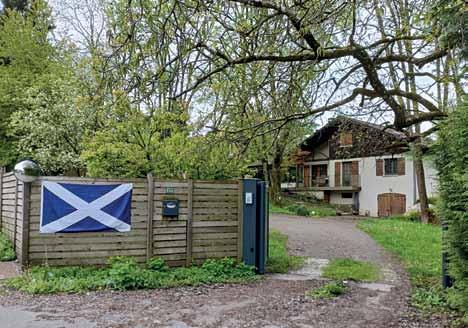
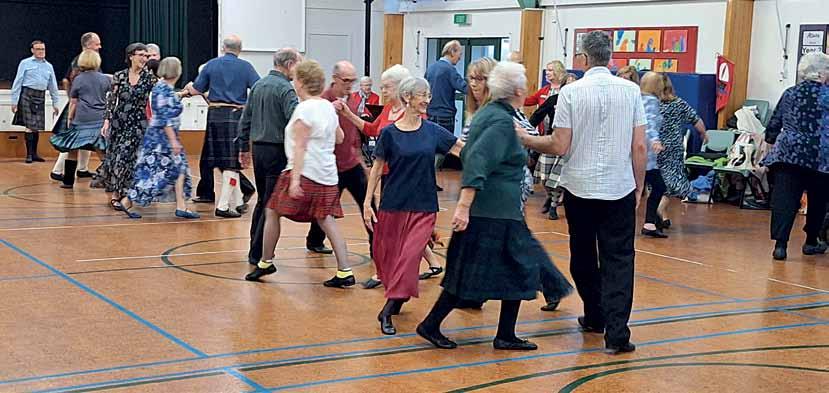
Alex Duthie, Chair of Kaiwaka Club of the New Zealand Branch, writes about Chair William Williamson and Linda Williamson’s visit to his part of the world. Alex is a relatively new dancer, having started in 2018, but has some thoughtful remarks to share with all of us.
At Kaiwaka Club, we have been focusing on having fun while dancing. We want excellence in dancing, but we feel that people mainly come to enjoy themselves. Sometimes, this means we might not spend as much time perfecting footwork as we might on getting people up and dancing, especially with beginners. Those looking to improve their dancing further are able to attend day schools and workshops around the AucklandNorthland Region that focus on technical quality. This approach has not always been met with support from some teachers. However, it has successfully created a vibrant, inclusive club.
Last year, we held a Labour Weekend School with the theme of fun. Teachers from around New Zealand supported this philosophy and incorporated fun into their classes. The weekend turned out to be a roaring success.
As demographics change and society’s structure moves with technology in directions perhaps less encouraging for country dancers, I think SCD needs to adapt, particularly to meet the needs of
the market its members come from. This is especially important for younger people.
I recently attended a King’s Birthday weekend school in the Waikato region of New Zealand. A ceilidh was held in a rural hall as part of the weekend events. The SCD organisers ran it, but it was aimed at the local community. The hall was packed with people from the surrounding area; over 100 people attended, all ages from 3 years old up into the 90s.
It was so good to see younger people actively enjoying their own real culture rather than sitting looking at an iPad at a manufactured culture.
While not every Scottish dancer’s cup of tea (some didn’t come and some left early), it showed a demand for that sort of thing, and who knows, we might get some new members. The remaining SCD members helped make the dances work while thoroughly enjoying themselves.
When William visited New Zealand, I attended a meeting in Auckland, heard him speak, and took part in some dancing afterwards. I thought he was an excellent
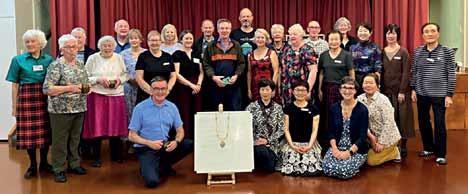
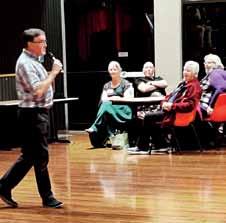
speaker who drew his audience along with him – a breath of fresh air, so to speak.
I thought the key to his message was inclusivity and understanding your market. This aligned with what we are endeavouring to promote. Teachers need to adopt that sort of approach. That message from the very top sets the tone for the organisation and tells those sceptics that this is the direction they should be taking.
A little later, I attended the Winter School at Gatton in Queensland. Again, I saw William at work. This time, I could see an attitudinal change beginning to take hold. Some of the more conservative long-time dancers/teachers were making efforts to be more inclusive than in the past. It was good to see.
William and his wife Linda left a lasting impression on dancers Down Under that could lead to positive change. I hope Gary will continue to build on the groundwork they have laid.

Any opinions expressed in the letters below are personal to the writers and do not reflect the views of the RSCDS or the Management Board
Dear Editor
We are good as a nation at moaning and complaining when things go wrong, but we are not nearly as good at saying ‘Thank You.’ I have just returned from two weeks as Depute Director at St Andrews Summer School, that month-long spectacularly enjoyable event which brings together members worldwide. In one of many small gatherings, we discussed the costs of other organisations compared to the RSCDS. Belonging to the RSPB costs £60 and the National Trust a whopping £90 per year, while our annual membership is a mere £28 plus whatever the local branch adds on. This seems like exceptionally good value for money and leaves me bewildered when some dancers complain about membership fees. Our Society certainly provides more friendship, fun, and laughter than any other organisation I belong to. It is also astonishing how much cardiac fitness our hobby offers. A regular gym club member came back to dance with us recently and remarked how much energy we use in dancing –certainly more fun than a treadmill in a gym costing a great deal of money! We are also much better informed than we used to be via our biannual glossy magazine, the Branch Mailings, the monthly newsletter Dance ScottishTogether and more recently, the informative and entertaining Blether There are also a variety of social media posts on Facebook, Instagram, and Twitter that amuse, entertain, and inform. We can keep in touch with other members of our worldwide family in various ways, which is one of the most valuable aspects of belonging to the RSCDS. Even if we choose to stay local, the Scottish dance family is always there to support or celebrate equally. It must surely be time to say one big thank you to the administrative staff, the officers of the Society and all the volunteers who make this amazing family of ours such a brilliant organisation to belong to.
Di Rooney,Cheshire Branch
Dear Editor
As a past Membership Secretary (involving the collection of c250 branch subscriptions) and past Treasurer of the Glasgow Branch (providing awareness of all income and expenditure), I am writing in response to Tom Ward’s letter outlining the lack of clarity regarding the Society’s expenditures as I also have concerns. When I first became Membership Secretary of our branch, the Society portion of the subscription was £10 and the Branch portion £5, a ratio of 2:1. Even then, I was frequently asked why the Society portion was so high! Today, over a decade later, this ratio has risen to 4:1. Only recently, our branch subscription increased to £7. The seemingly ever-increasing Society membership fee makes it much harder for branches to recruit new members –‘what do I get for my £28?’ is becoming a challenging question to answer.
Over the years, the impression has been given that the Society operates on the principle of deciding on a programme of activities and then, when costed, simply asking the branches to ‘fill the hole’.
I note that at the recent Board Meeting, there was a proposal to ‘recommend a one-year pause in subscription increases over the five-year forecast period’. Whilst welcome, this is not a longterm solution and does not address the underlying problem. What happens after the one-year pause—will it be followed by a larger increase in subsequent years?
Surely, the Society should aim to live within its means. Look realistically at what can be delivered within the existing budget,
focus on key activities, and plan to deliver within this framework. This may take a few years, but it should start now. Some difficult questions may need to be asked. Do staff costs need to be reviewed? Is 12 Coates Cresent too expensive to maintain? I recognise that these are not easy decisions, but the status quo is fast becoming a non-option.
We should not forget that the RSCDS is a charity whose primary aim is promoting Scottish dancing. This is what it should be focussing on, and what I suspect most members hope is what their subscription is being used for.
On behalf of the worldwide Scottish dancing community, I would ask the Management Board to consider these remarks and remember that they represent that community. I am sure that we all appreciate the efforts of the many volunteers and staff who work for the Society; however, it appears that the direction of effort requires a rethink and a shift to a more effective organisation.
MaryWebster,Glasgow Branch
Dear Editor
{Editor: ..This author suggested the recent Footcare and Footwear article to the editorial team inAugust 2023.)
Thank you for the article on Footcare and Footwear in the April 2024 Scottish Country Dancer. It was just what I was hoping for. One minor error - there are 192 jumps in a six-step Highland Fling, not 102. No wonder it puts a strain on the feet!
I agree with much of what is said in the article about Stockbridge Scottish Reelers. Reeling is a good way of introducing newcomers to SCD. However, I’m afraid I have to disagree with the author that strathspeys are boring. I am 70 years old and have been dancing for nearly 50 years. I now have Parkinson’s disease, and I am unable to dance many quick dances, so my dancing consists mainly of strathspeys. I love them, and their music is beautiful. It has variety - there are true strathspeys with a bumpy dotted rhythm and slow airs which glide along.
Elizabeth Bennett,Croydon & District Branch and London Branch
Dear Editor
I read the recently released RSCDSGuideToEtiquette with shock and sadness. Surely, the paragraph headed “It’s okay to say no” couldn’t be true. Accepting one person after rejecting another has never been acceptable and never will be.
It contradicts a paragraph above it, which says (correctly) that we should watch our language so we don’t offend. However, as we know about actions and words, we stand more chance of offending, upsetting, or embarrassing someone by following the rejection/acceptance scenario than by any words.
With 50 years of dancing and teaching behind me, I wonder how these guidelines were agreed upon. The individual’s rights have been put before the rights of the majority to an uncomfortable degree. Giving permission to stop dancing with someone at any time cannot possibly mean precisely what it says.
Scottish country dancing has always been open, sociable, friendly and welcoming. This appears to legitimise the opposite.
My Club was horrified when three of us acted out the reject/accept scenario. From beginners to very experienced, it was rejected.
I urge the Society to rethink and revise the guidelines so we remain polite, inclusive, welcoming, and mindful of the feelings of all dancers.
Fiona Bullivant, New Zealand Branch
We would appreciate if obituaries (max 150 words) come from branch or club secretaries.
Betty Lee Barnes
Elizabeth (Betty Lee) Barnes was a major force in teaching the southeast USA to dance. She worked for the National Endowment for the Arts in Washington, DC. Starting Scottish dancing in 1964, she taught, composed dances and, along with her husband Duard, hosted parties and musicians before the vision of a dance school manifested. With help from members of Atlanta Branch, the first Thistle School happened in July 1980 at Lees McRae College in Banner Elk, NC. Candidate classes were started in 1982. She arranged for Bobby Brown to come from Canada to play and teach. In 2000, she was a recipient of the Society’s Scroll of Honour. Her enthusiastic direction and fostering of community continued with the Thistle School for 39 years. She brought joy to so many with friendship and personal touches. Betty Lee’s legacy continues to be the inspiration for Blue Ridge Scottish Dance School.
Mary McConnell,Carolinas Branch
Ruth Barnes, Belfast
It is with deep sadness and heavy hearts that the Belfast Branch mourns the death of our beloved friend, Ruth. Ruth started dancing around 1957 and in 1958 joined Belfast Branch, where she met her future husband, Ronnie. They both qualified as Scottish country dance teachers in 1967. Ruth started teaching a beginners’ class, then what became Castlereagh class, and stayed for 45 years. Ruth served the Belfast Branch as Chairman, and, with Ronnie, was given a Branch Award. She was an accomplished dance deviser, as well as demonstration team member at St Andrews and Belfast. She was a gentle and sensitive class teacher. Ruth endured a long illness with great fortitude and valour; she displayed great loyalty to her class which she attended two weeks before she died. She enriched the lives of all who knew her and is greatly missed by her family, fellow dancers and friends.
John Campbell,Belfast Branch
Malcolm Brown, York & North Humberside
The loss of Malcolm Brown is sadly felt, not just at the local level but also internationally. In 1975, Malcolm was co-founder of the York and North Humberside Branch. While being totally committed to the Branch, he also found time to tutor candidate courses in the UK and abroad. He gained an international reputation as a tutor and teacher, especially in Russia. His contribution was recognised in 2010 with the Society’s Scroll of Honour. He was a member of the RSCDS Management Board and Convenor of the Education & Training Committee from 2016 to 2019, where he worked to introduce what is now the CTI programme. He will be remembered for his passion for SCD, his inclusivity, his early filming of life at St Andrews summer school, the dances he devised, the teachers he trained and certainly for his own personal legacy of establishing three generations of SCD teachers.
Helen Russell,York & North Humberside Branch
Joyce Deddens
Joyce Deddens saw Vicky Goodloe’s Lexington Demonstration Team perform and decided that she wanted to learn Scottish country dancing. At Joyce’s invitation, Vicky drove to Louisville weekly to teach. As that became harder for Vicky, Joyce took over the class and eventually became the first fully-certificated RSCDS teacher in Louisville. She was instrumental in the formation of the Louisville RSCDS Branch, and was their primary teacher for many years. Joyce contributed much to the success of the Branch: she formed and led the Louisville SCD Demonstration Team; organized and led activities at Kentucky Scottish Weekend and Glasgow Highland Games; helped organize Balls in Louisville; helped with candidate classes; and taught workshops. After her retirement, she and her son, Brendan, moved to Brookneal, Virgina. After Brendan’s death, Joyce moved to Guatemala to be near her daughter, Jennifer. Those who knew Joyce have missed her ever since she left.
Nancy Logan,Central Kentucky Branch
Christine Hall
It is with great sadness that Malvern RSCDS record the death of Christine Hall after a short illness. She was one of our most valued members for over 40 years. Christine was well known for her patient teaching at beginners’ classes and for taking many evening sessions where her wide knowledge of and enthusiasm for Scottish country dancing was evident. Christine also ran the Worcester group for some years and for the last seven years she organised monthly Saturday afternoon dances at Powick. Many dancers will remember Christine as she and her daughter Anna attended the local dances run by other Midland groups. Christine was a wonderful example of a proficient and knowledgeable dancer who was delighted to help others share in her passion.
Sue Sadler, President, Malvern RSCDS
Shigeko Igarashi
Shigeko Igarashi was one of the founding members of Tokyo Branch, the first in Japan. She was certificated as a teacher in 1992 at St Andrews and was invited to Korea to teach SCD twice. In 2004 and 2006, she served as the Chair and hosted the 20th anniversary event of the Branch. As a tutor and exams organiser, she has trained many teachers and was awarded the Society’s Scroll of Honour in 2010. She has been teaching at Akabane SCDC in Tokyo for over 35 years and has always pointed out the importance of the basic steps. The annual ball in November always attracted more than 100 dancers in her honour. We offer our deepest condolences.
Yumiko Kosugi,Tokyo Branch
Marie McLennan
Marie recently celebrated sixty years of teaching all levels and age groups within the Branch. She would often identify an opportunity and launch classes elsewhere for small but dedicated groups. As Teachers’ Council Chair, she served many rotational terms on the Committee of Management. She organized and trained demonstration teams to perform at events and festivals throughout the region and was honoured by the Government of Ontario for her community cultural work. In 1997, she and her late husband and fellow teacher, Bill, received the Society’s Scroll of Honour. In 2011, they also received the Branch Award. Her generous hospitality for Branch gatherings, mentoring of new teachers, and encouragement of dancers to attend workshops and weekends are all part of her continuing legacy to Scottish Country Dancing in this area.
Janet Schreiber, RSCDS London Canada
Elsa Mearkle
Elsa Mearkle was born in 1922 in Montrose and brought up in Aberdeen, graduating from the University of Aberdeen Medical School. After hospital appointments and a spell in general practice, she joined the Royal Air Force Medical Service and was based in Singapore, where she met and married RAF Doctor John McCabe. On their return to the United Kingdom for “demob”, they lived, studied and worked in London for three years, then travelled to South Africa. They spent many years there, Elsa working in the State Hospitals. Two sons completed the family, but sadly John died young. Elsa joined the Leprosy Mission Southern Africa to head up their Treatment Fields. On a study trip to Carville Hospital near Baton Rouge she met Hugh Mearkle, which led to a second marriage and brought her to Twin Falls. A teacher and adjudicator of Scottish country dancing, Elsa danced wherever she lived.
Peter McLeod,CapeTown
Isabelle Smith
Scottish country dancers and musicians were deeply saddened to learn that Isabelle Smith had passed away. Having obtained the full RSCDS teaching qualification in 1990, Isabelle went on to become an enthusiastic organizer of music and dancing events in the New York area.
Besides teaching, Isabelle devoted great effort to encouraging the playing of Scottish country dance music. She formed the ‘Cameron Music Ensemble,’ which brought together anyone with an interest in the music, however much or little they already knew. Numerous tributes have been received from musicians and dancers who benefited from the Cameron workshops.
Renowned fiddler Elke Baker writes: “Whether it was music workshops, live music for dance classes, dance and music performances, step dance classes, fun and innovative ideas to bring Scottish dance and music to more people, Isabelle was a tireless advocate, a doer, a mover, and not afraid to shake things up a bit.”
Chris Ronald,past President of the NewYork Branch.
Ian Brockbank compiles the Day School Diary. Please send details to ian@scottishdance.net . Issue 40 will cover events from April to December 2025
OCTOBER 2024
5 York & N. Humberside Branch Half-Day School, Stockton on the Forest, York, UK
11-13 RSCDS Paris Branch 40th Anniversary Weekend, France
14-18 Holiday for Advanced Dancers, Torquay Leisure Hotels, Torquay, Devon, UK
17-20 Central Germany Intermediate Autumn Course, Kuckucksnest/Schlüchtern, Germany
18-20 RSCDS Sutton Coldfield Weekend of Dance at Rendezvous Hotel, Skipton UK
18-20 RSCDS Youth Branch - Youth Weekend Away workshop & ball in Basel, Switzerland
26 Isle of Wight “New Dances” workshop, Arreton Community Hall PO30 3AD, UK
NOVEMBER 2024
1-3 RSCDS Autumn Gathering, Edinburgh, Scotland, UK
1-3 Asilomar Weekend Workshop, Pacific Grove, CA, USA
2 Nova Scotia Branch workshop, Dartmouth, Nova Scotia, Canada
8-10 RSCDS Croydon Weekend School at Eastbourne, UK
8-10 Argyle Weekend, Northern Virginia Branch (Washington, DC area), USA
9 Bristol RSCDS Day School & Dance, St Peter’s Church Hall, BS9 4LD, UK
9 Sheffield RSCDS Day School, Coal Aston, Sheffield, UK
16 RSCDS Norwich Branch Day School, Unthank Road, Norwich, Norfolk NR2 2PA
20-24 Central Germany Very Advanced course, Kuckucksnest/ Schlüchtern, Germany
22-24 RSCDS Southern Fling, Melbourne, Australia
29-1 Dec RSCDS Leeds Malhamdale Weekend, UK
DECEMBER 2024
28-5 Jan NZ Branch Summer School, Wellington, New Zealand JANuARY 2025
17-20 Weekend for Advanced Dancers, Ocean Beach Hotel and Spa, Bournemouth, UK
18 Isle of Wight Beginners/Improvers workshop, Gurnard Village Hall, PO31 8JR, UK
25 RSCDS Paris Branch Annual Day School, Paris, France
31-2 Feb York & N. Humberside Branch Weekend School, Cairn Hotel, Harrogate, UK
FEBRuARY 2025
8 Newark SCDS Day School, Bridge Community Centre, Newark, NG24 2DQ
14-16 Isle of Wight Weekend School, Shanklin Hotel, Isle of Wight, PO37 6DP
16–21 RSCDS Winter School, Pitlochry, Scotland, UK
27-Mar 2 Central Germany Spring course, Kuckucksnest/Schlüchtern, Germany
28-Mar 2 RSCDS Bristol Dance Weekend, Langstone Cliff Hotel, Dawlish Warren, EX7 0NA
MARCH 2025
1 RSCDS Leeds Musicians’ Day
7-9 29th Iberian Gathering, Tarragona, Spain
8 BHS Border Branch Day School and Musician’s Workshop, Crowthorne
8 Isle of Wight “New Dances” workshop, Arreton Community Hall PO30 3AD, UK
14-15 Atlanta Branch Spring Workshop, Cartersville, GA, USA
14-15 RSCDS Oban and Lorn Branch Weekend School, Corran Halls, Oban, Scotland
15-16 RSCDS Tokai Branch Weekend Camp, Atami, Japan
22 West End Workshop (Toronto): Day Workshop with Tea dance, Etobicoke, Toronto
23 Teachers’ Workshop, Etobicoke, Toronto, Canada
29-30 San Diego Branch 50th Anniversary Weekend, San Diego, CA, USA
APRIL 2025
4-6 Washington DC Branch Capital Weekend, Washington, DC, USA
5 RSCDS Helensburgh Day School & Dance, Parish Church Hall, Helensburgh, UK
5 Frankfurt SCD Club’s Annual Day School and Ball, MühlheimDietesheim, Germany
11-13 RSCDS Spring Fling, Brighton & Hove, England, UK
11-13 Lyon Branch SCD and music workshop, Lyon, France
17-21 Central Germany Easter course, Kuckucksnest/Schlüchtern, Germany
26 RSCDS Winnipeg One Day Workshop, Churchill Park UC, Winnipeg, MB, Canada
MAY 2025
1-4 Potters Pairs 25th Jubilee, Hof Oberlethe, Wardenburg, Germany
16-18 Duns May Weekend, Scotland, UK
16-18 Pawling Weekend 2025, Copake, New York, USA
17 Isle of Wight Beginners/Improvers workshop, Gurnard Village Hall, PO31 8JR, UK
JuNE 2025
6-8 Midwest Scottish Weekend, Wayland Academy, Beaver Dam, WI, USA
6-9 Munich Scottish Association Whitsun Course, the Salesianum, Munich, Germany
13-15 Cammac Scottish Country Dance Retreat, Harrington, Quebec, Canada
25-29 Central Germany Summer Course & Ball, Kuckucksnest/ Schlüchtern, Germany
JuLY 2025
4-7 Pinewoods Session I, Plymouth, MA, USA
7-12 Pinewoods Session II, Plymouth, MA, USA
5-12 48th Australian Winter School, Shoal Bay, New South Wales, Australia
6-12 Blue Ridge Scottish Dance School, Boone, NC, USA
12 White Rose Festival, Leeds, UK
13-Aug 10 RSCDS Summer School, St Andrews, Scotland, UK
The Day School Diary has space for day and weekend schools only. For other events in your area, please check:
l Scotland and Cumbria: https://scotdancediary.co.uk/
l Europe: http://www.celtic-circle.de/events.html
l Canada and uSA: https://intercityscot.org/eventList.php
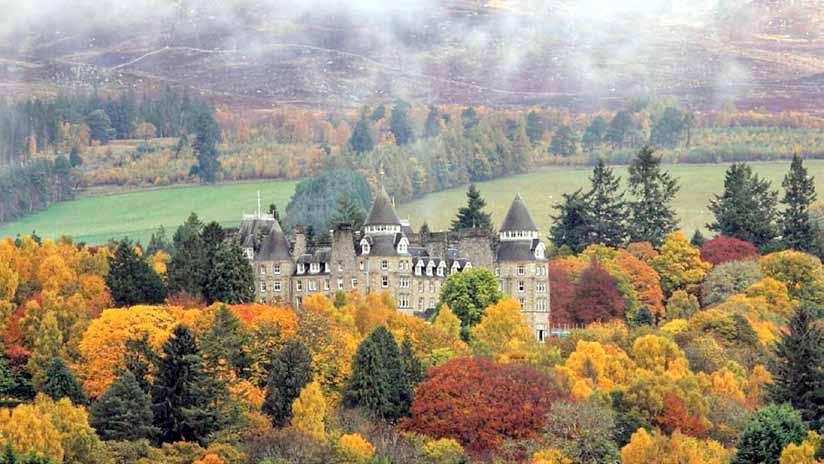
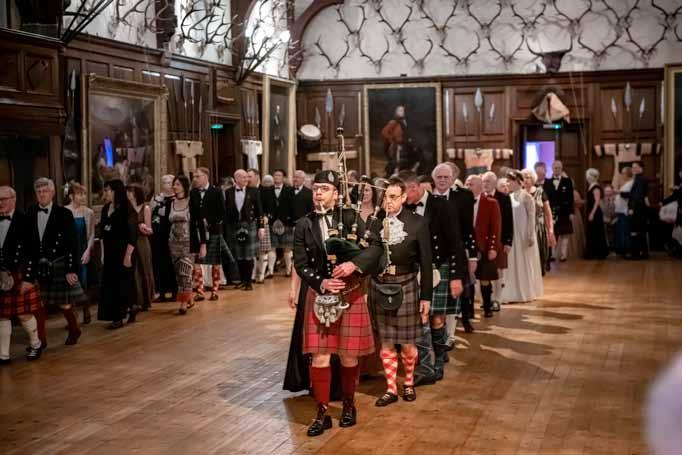

16-21 FEBRUARY 2025


